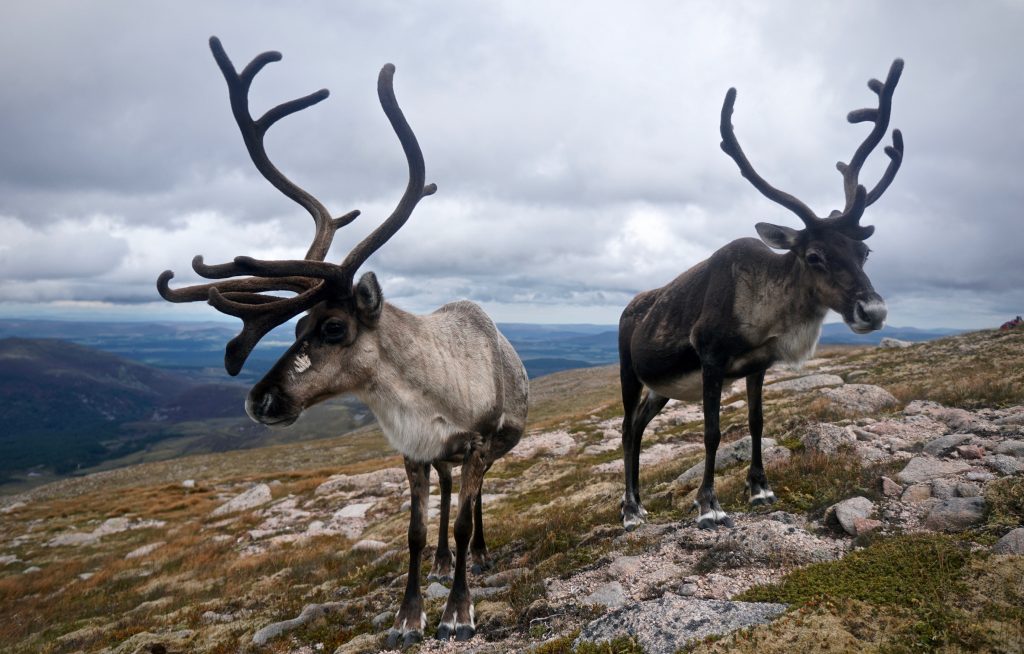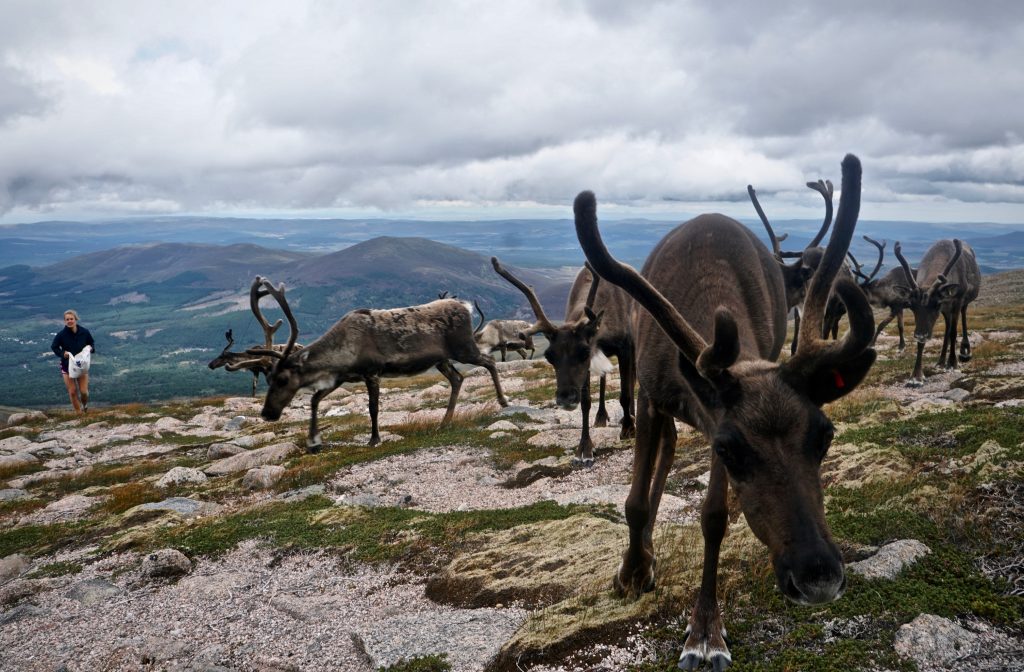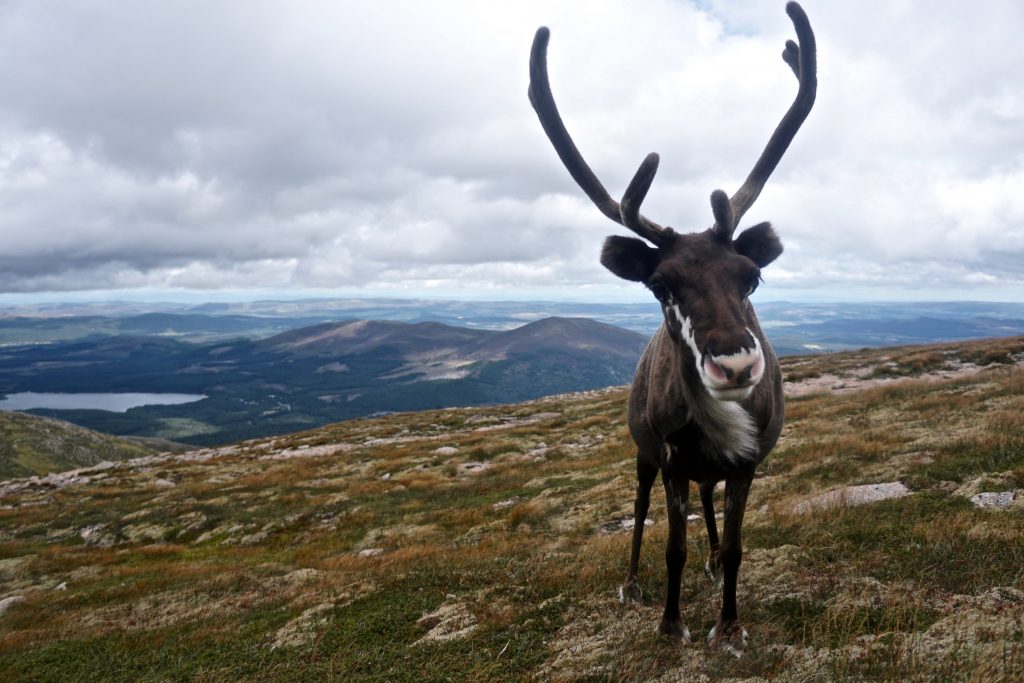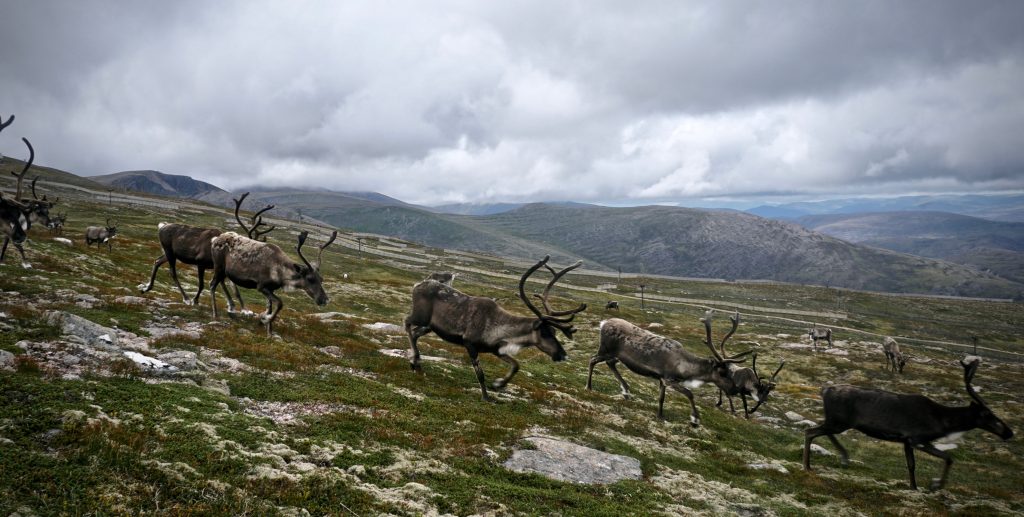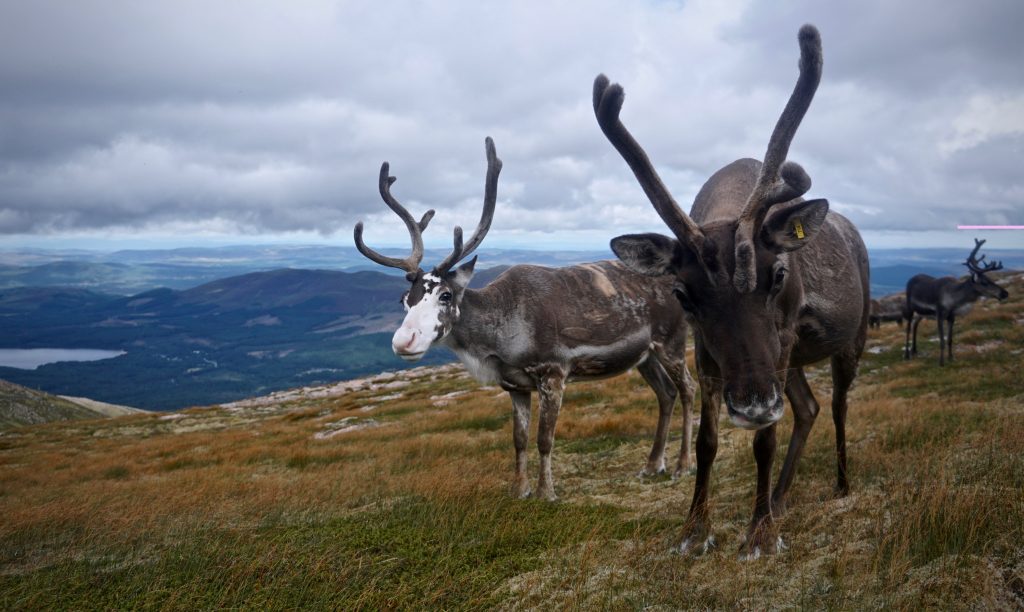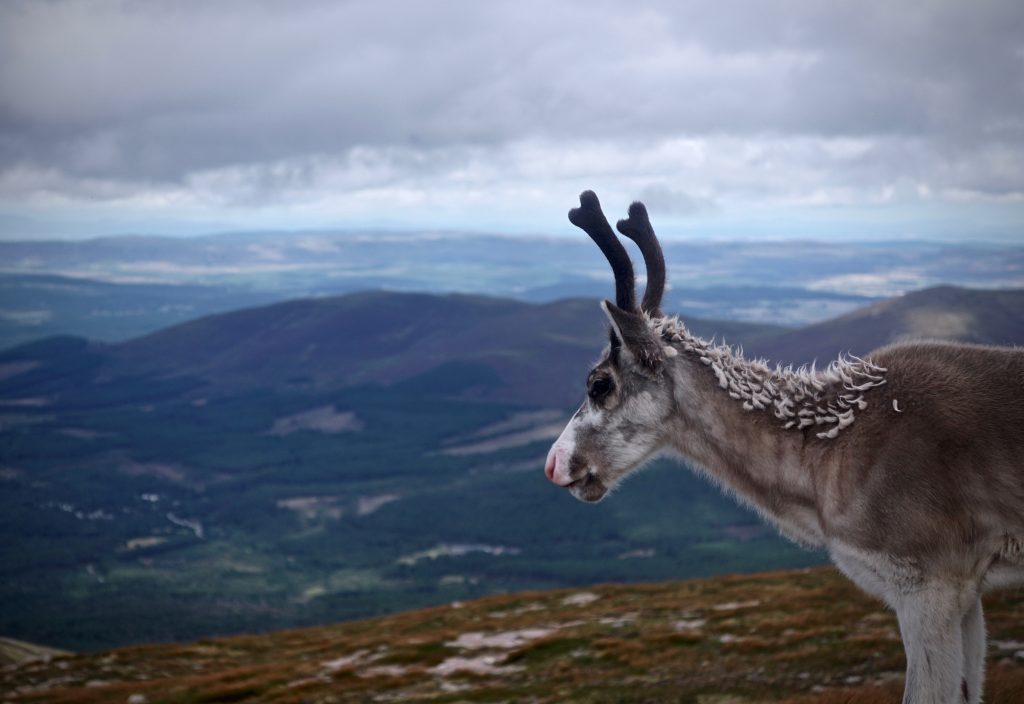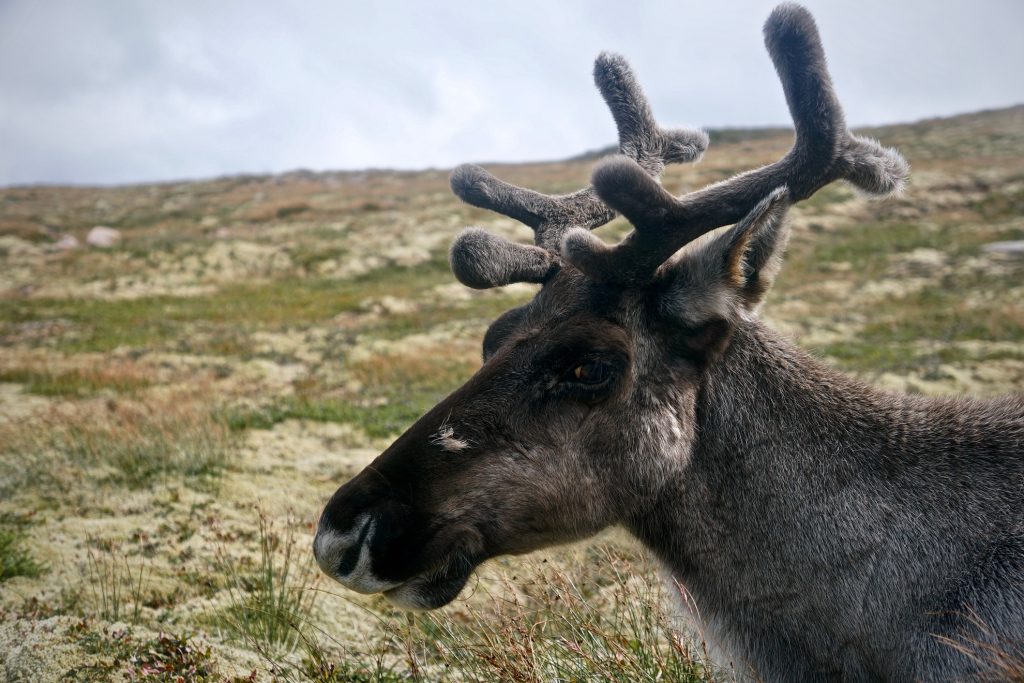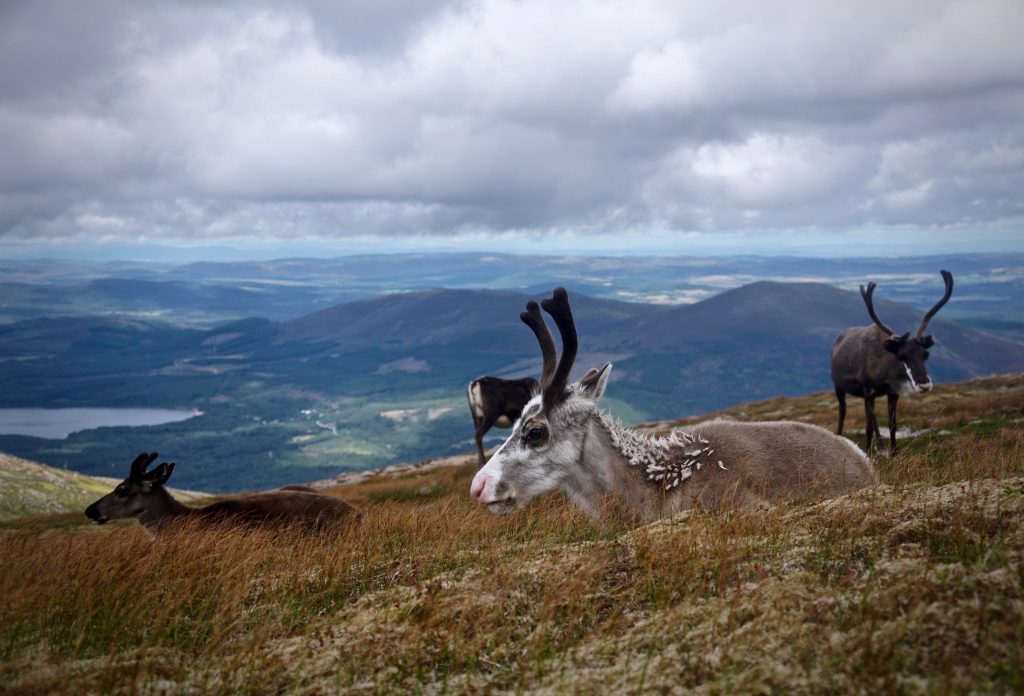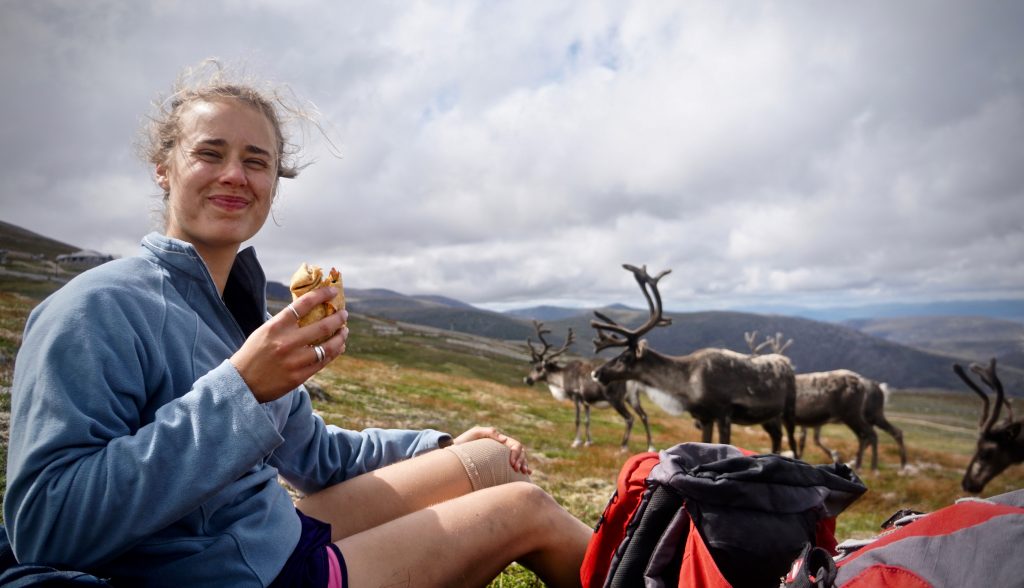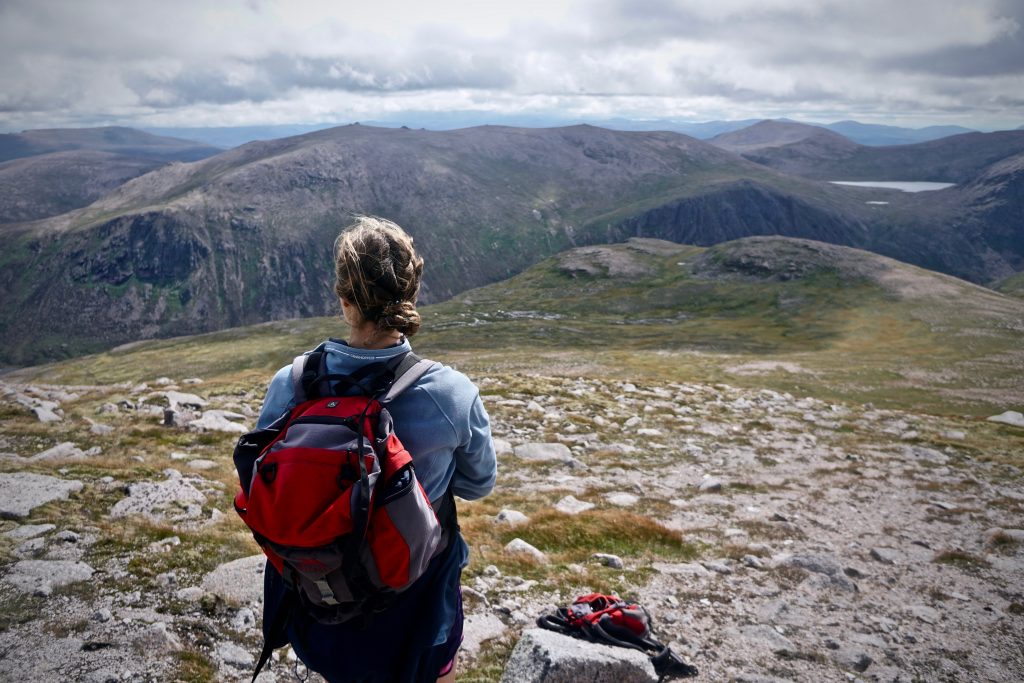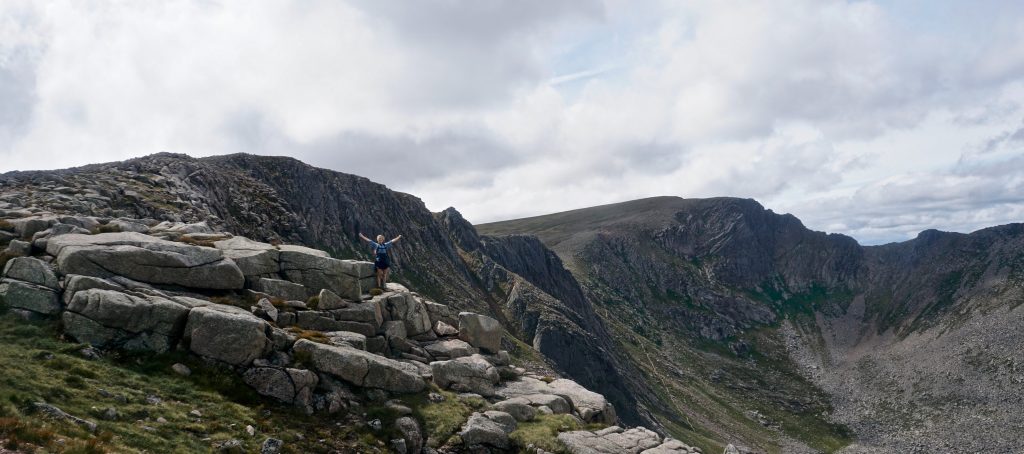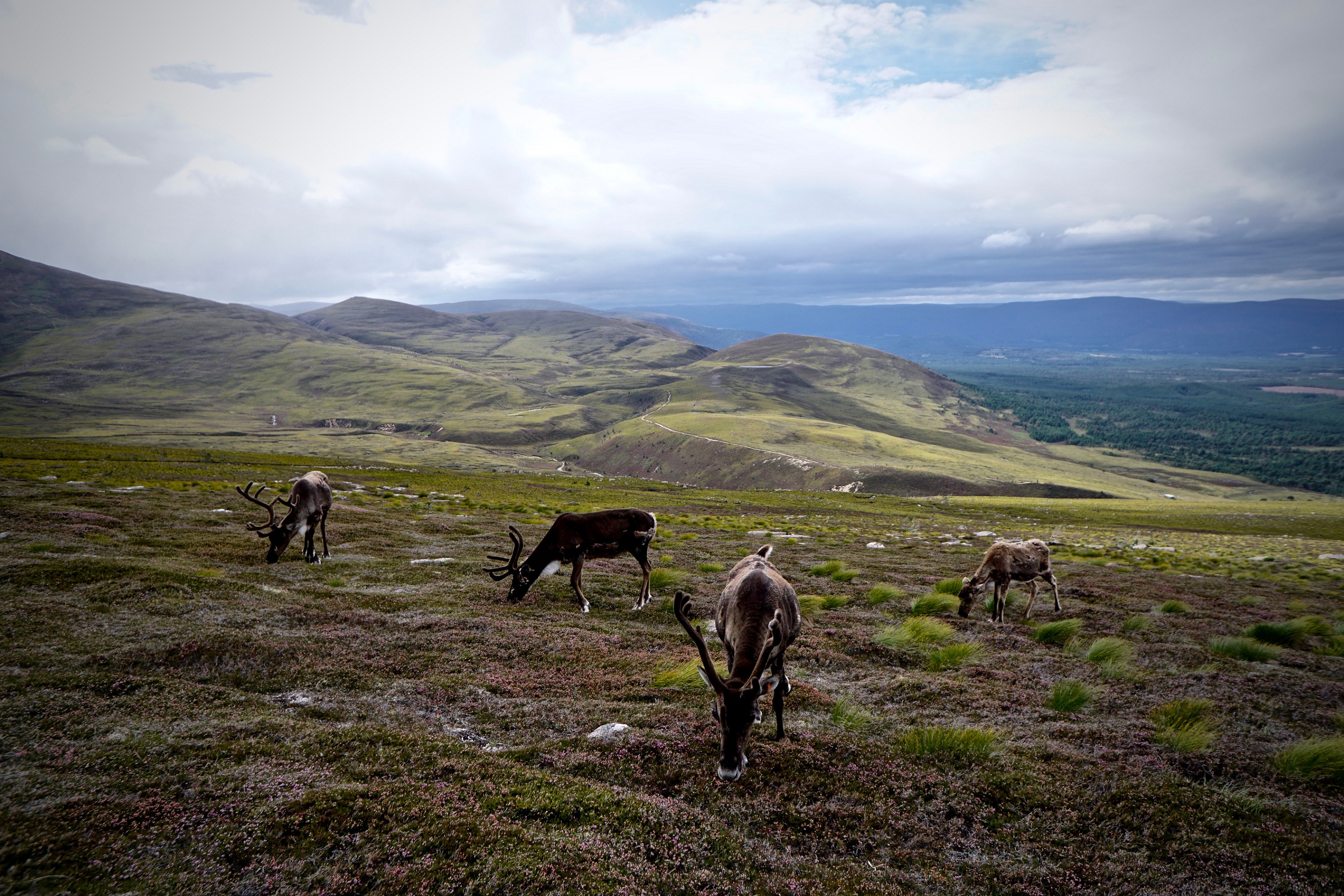
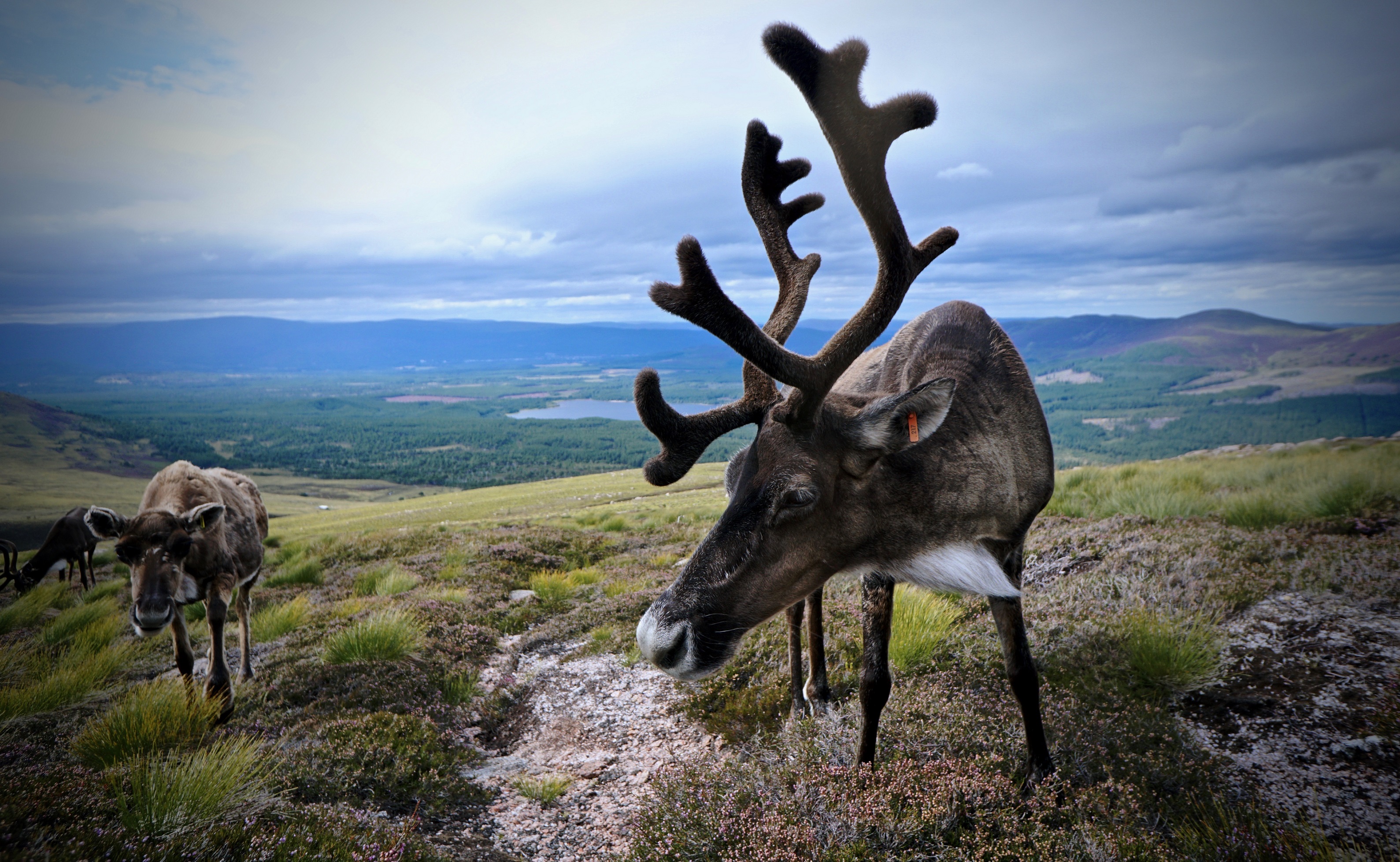
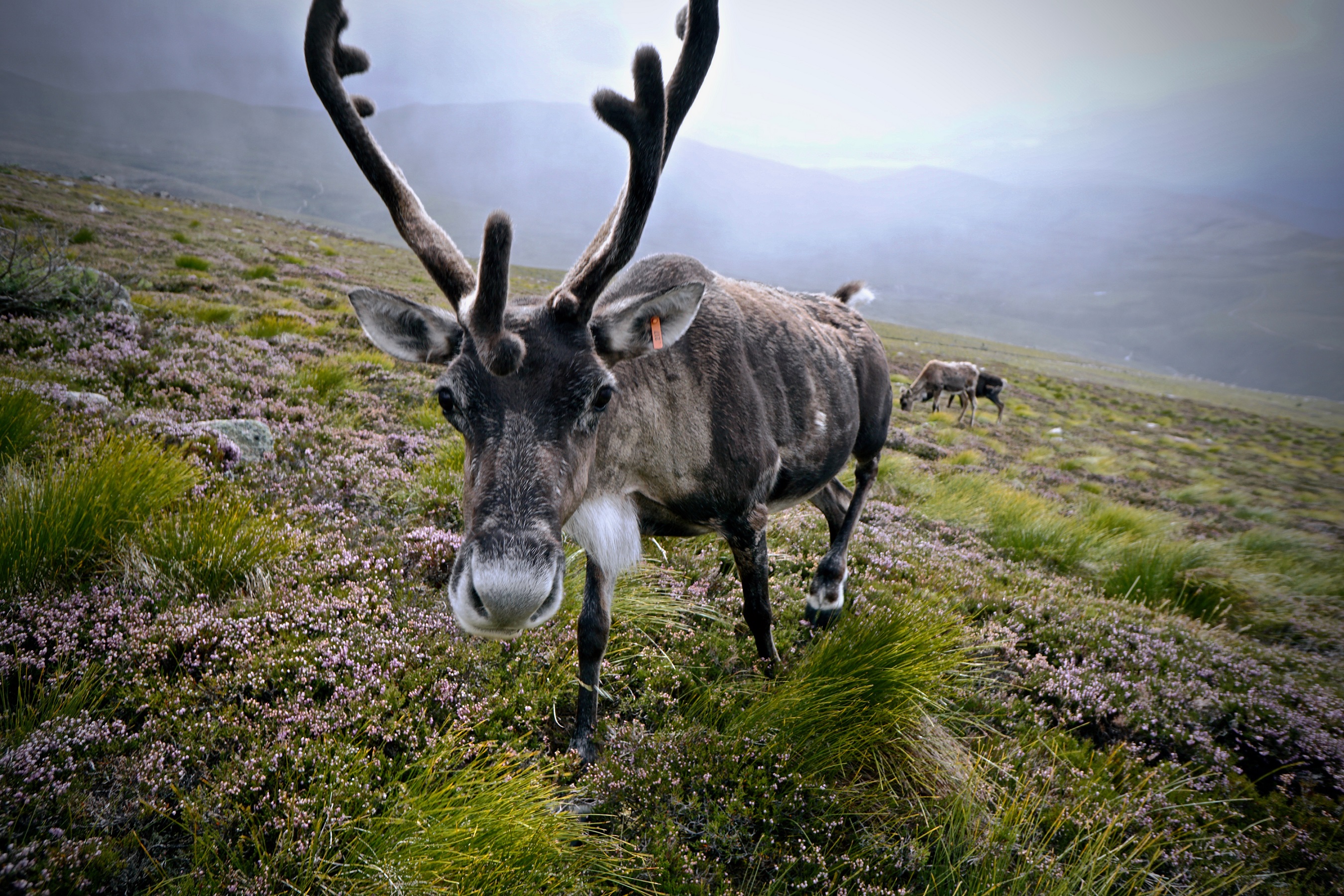
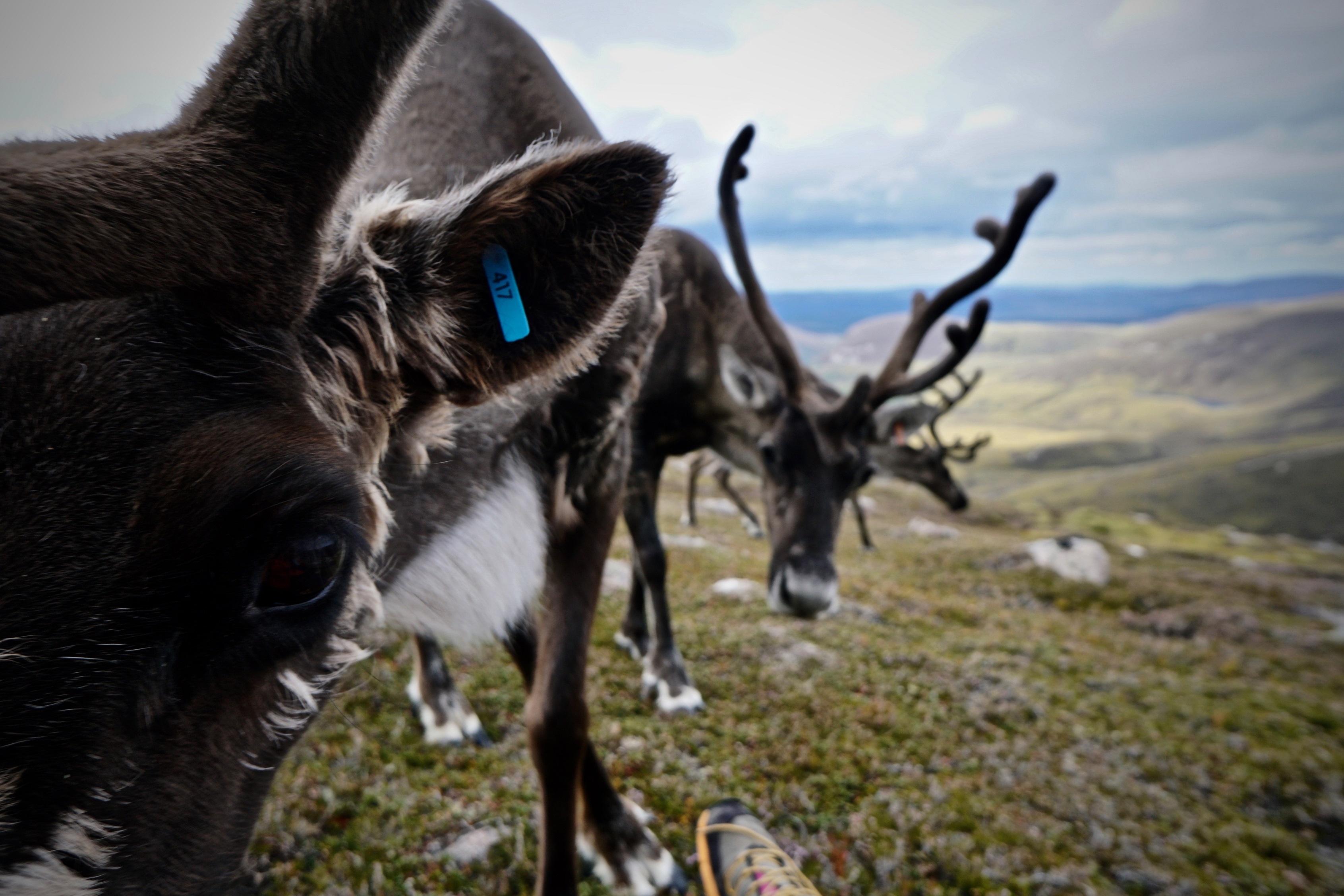
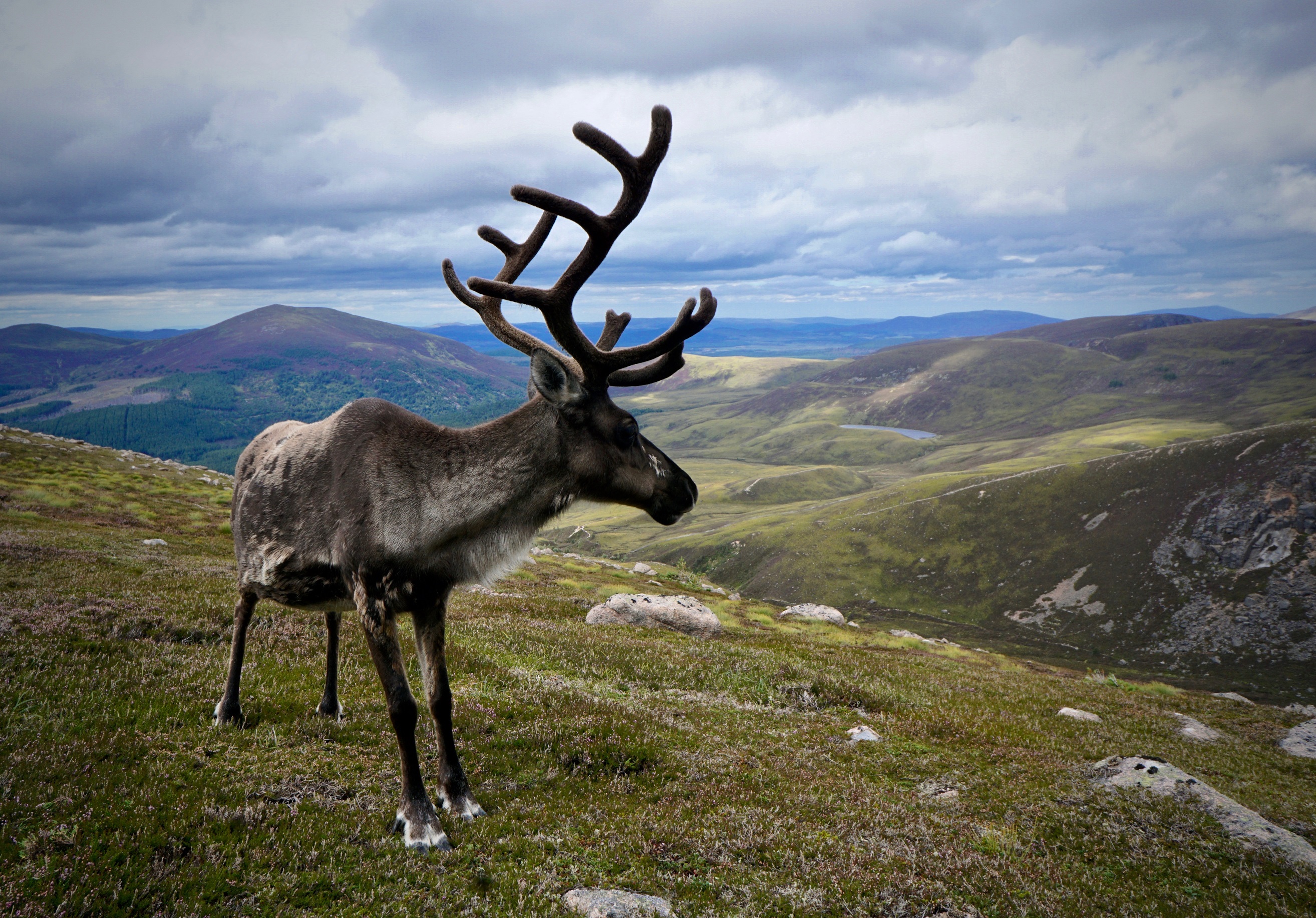
Julia

Roaming freely since 1952





Julia
Its well over two years now since Viking was born which also means I have been a Reindeer Herder for well over two years. It was my first trip into the hill enclosure that morning and it was chilly in early May when Fiona and I first caught a glimpse of young Viking. He was white all over and extremely floppy. Proud but casual Mother, Caddis, was right behind the wee man. From then on neither of us has looked back.
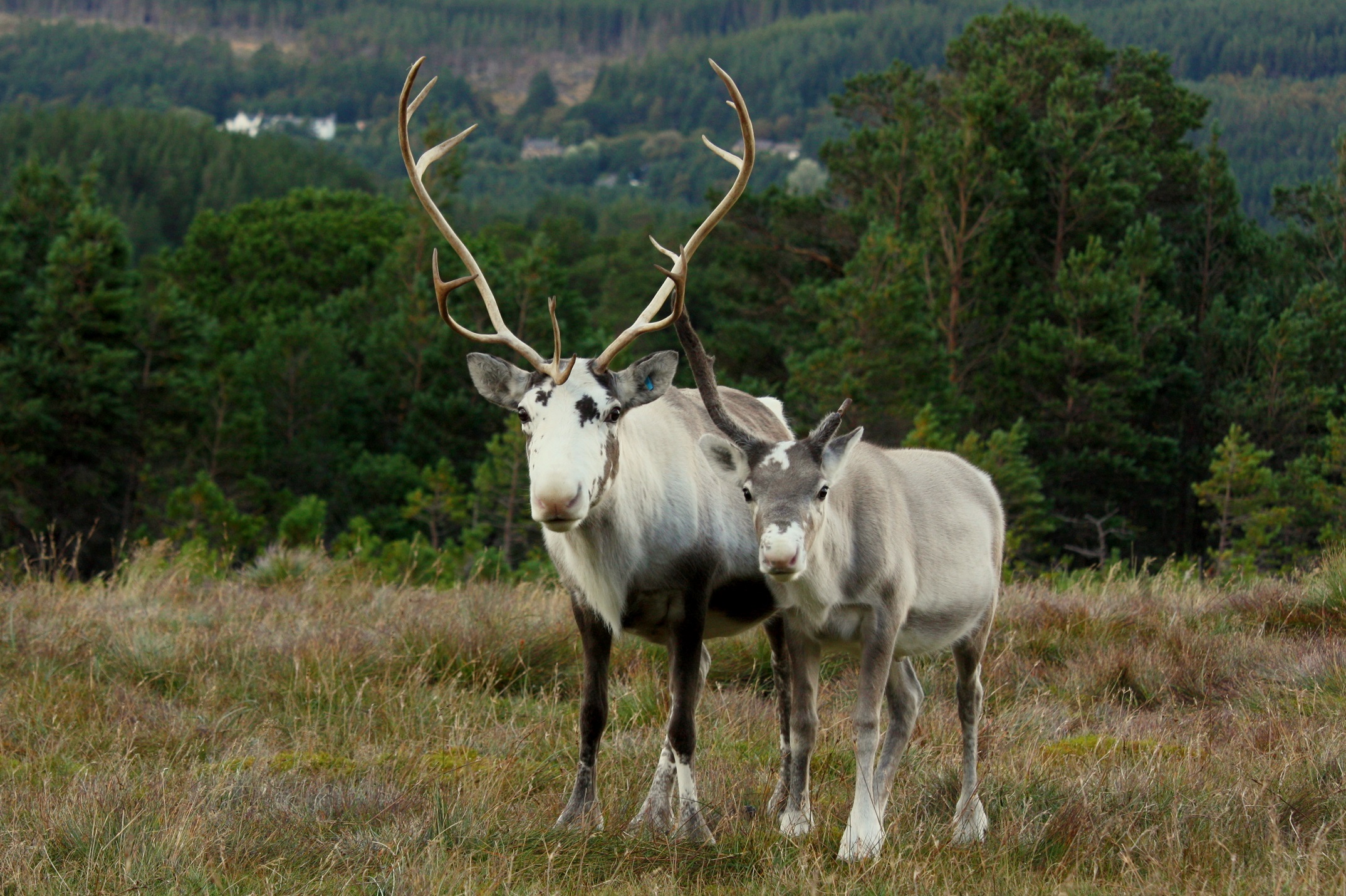
What great two years they have been. Both Viking and I have been maturing constantly. Keeping fit on the hill and building a real rapport with both staff and visitors. Both Viking and I have developed into real characters with handsome and striking features (haha). Viking has grown a great set of antlers this year and is showing real potential as a dominant male in the herd – I have not.

His coat is very light – silvery in the summer and white as snow in the winter. He has some darker patches on his face. My freckles have developed over the summer creating an equally patchy display. All up Viking and I are quite similar and I hope our friendship will continue for a long time yet.
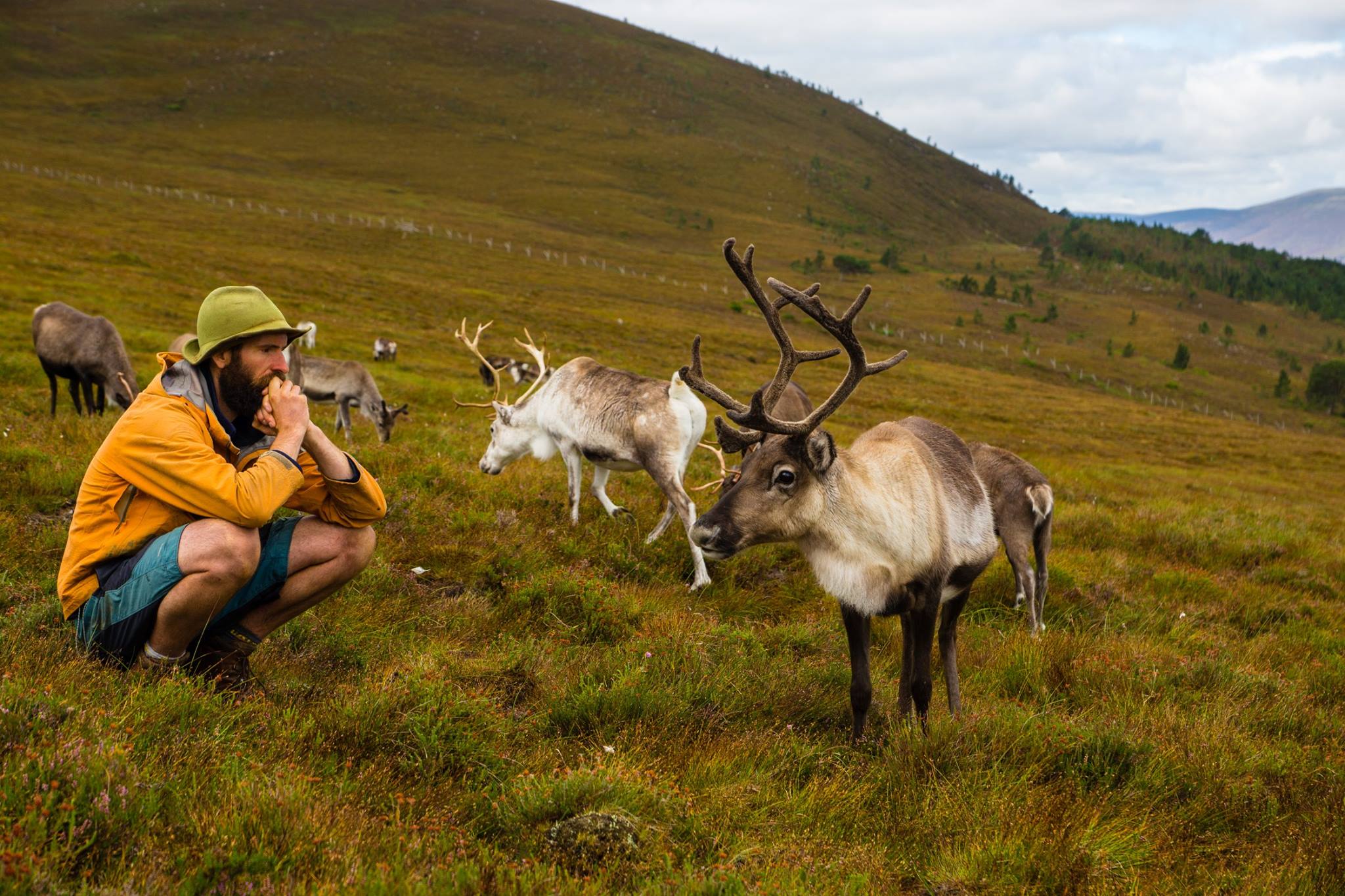
The years ahead are likely to be fun for both of us. Lots of work to be done keeping ourselves fit and healthy. The changing of seasons will bring many challenges but the rewards keep us going. During the third year of a males life is when the unfortunate and mildly traumatic process of castration is performed. THIS IS MOST DEFINITELY WHEN WE GO OUR SEPARATE WAYS!!
Dave
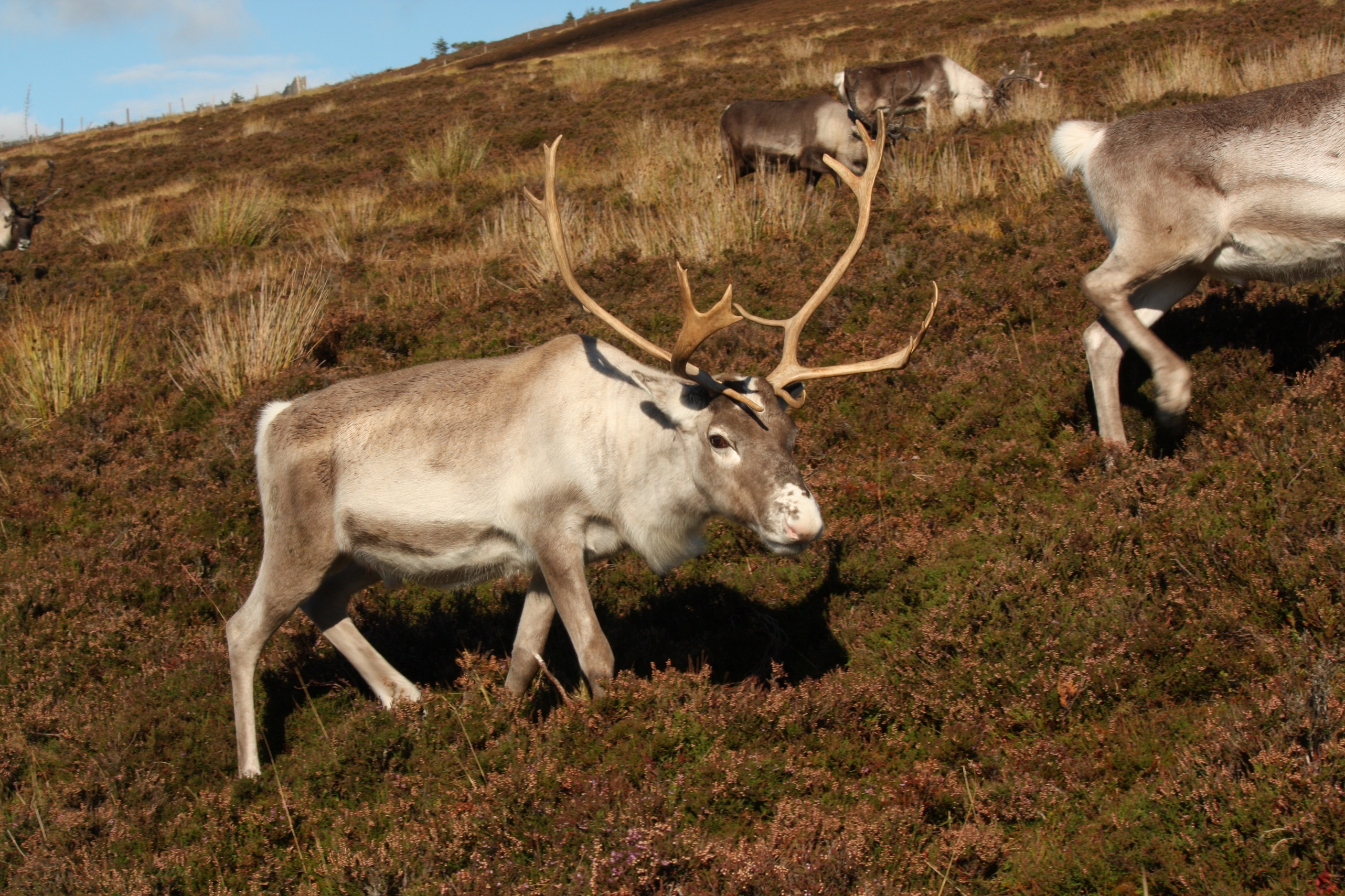
Earlier this year we sadly lost Sequin, one of our most well-known females of the herd. Tilly wrote this article about Sequin back in 2015 which we thought we would share once again.
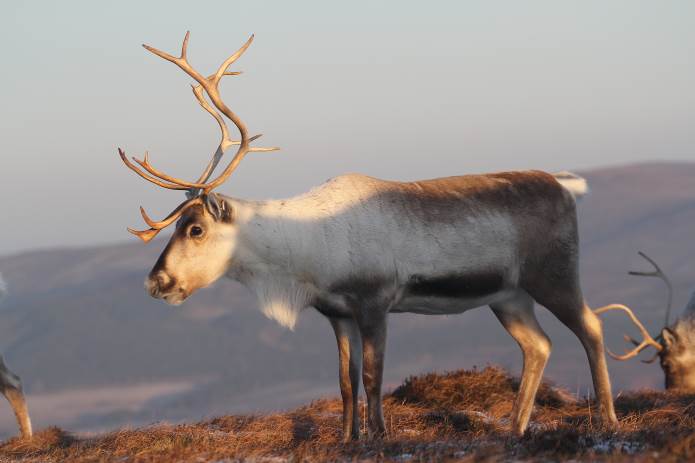
Sequin
Mother: Polo
Born 9th May 2002
Sequin is what we would describe as a ‘normal coloured reindeer’, with a dark back and light sides. However, in contrast, her mother Polo, grandmother Ferrari, great grandmother Vivi, great great grandmother Stina, great great great grandmother Snowflake and great great great great grandmother May were all white or very light coloured reindeer, so Sequin is very much the ‘black sheep’ of her extended family.
Whiteness in reindeer is a recessive gene and it is interesting to see how that colouring has been so persistent through the generations. I think this is probably due to Snowflake, who was actually an albino reindeer and must have passed on strong white genes to her daughter Stina. Sequin may be the odd one out in this long line of direct white relatives, but she has passed on the white gene to her 2013 calf Cambozola.
Sequin’s mother, Polo, was an extremely good looking reindeer, who always grew very pretty antlers and, with her good looks, almost regarded her calves as a fashion accessory! Sequin lived up to her mother’s expectations and is definitely a pretty reindeer, although she doesn’t always measure up when it comes to antlers as they have been known to be rather ‘wiggly’ in the past. But that’s maybe due to age!
At 13 years old Sequin is now one of our older female reindeer, which just makes me feel old too because I clearly remember when she was born – 2002, the year we celebrated 50 years of reindeer in Scotland. The calves born along with Sequin followed a theme of gold and to this day we still have five other reindeer born in 2002: Haze, Foil, Ring, Lilibet and Bangle. So you may well ask how does Lilibet fit into the gold theme? Well, 2002 was the Jubilee year for the Queen as well as for us, and ‘Lilibet’ was her nickname as a child.
Sequin is a real character in the herd; not only does she have four surviving calves of her own – Fern, Stenoa, Cambozola and North – who like their mother are very tame and greedy, but she is a grandmother to Ladybird and great grandmother to Baltic. A great family of reindeer in our herd.
Tilly
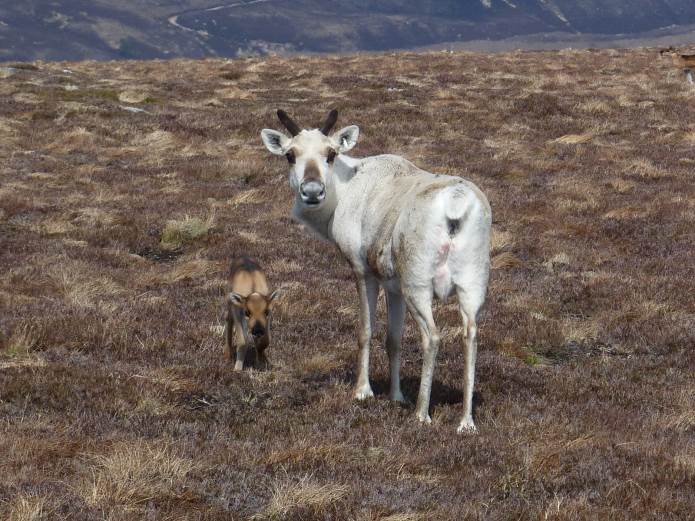
What do reindeer herders do when they meet reindeer when they are travelling abroad? Right, try to get some interaction! After having volunteered with the herd for a couple of weeks at different times last year, I had to finish my studies and for that I needed to do an internship in Norway (I know, poor me ;D). The lovely Trondheim, the town I lived in for 4 months, is surrounded by distant reindeer areas North, East and South of the city. I was really looking forward to meeting some Norwegian reindeer, and since I hadn’t seen them during the first week I was there (I mean, come on, it’s reindeer country!) I decided to just go to the nearest herd with a visitors centre, which was at a 2/3 hour drive away from home (practically nothing in Norwegian standards).

I met some beautiful reindeer behind a fence, but they were a bit far away… Then I got the slightly mad idea of trying to call them over the way we do in Scotland. I started at a very low volume but once I got their attention I decided to go for it, and they all came and meet me at the fence. It was really funny to see that these reindeer, so far from our herd in Scotland, actually seemed to react to the call we use there.

Later on I bumped into a herd that was free-ranging, tried the same thing, and had success again. The reindeer had been lying down, probably regurgitating some food they ate before, and they got up and came running towards me as soon as they heard the call.
I wonder if the reindeer I encountered reacted because our call is the same call used by Mikel Utsi, the Swedish Sami herder who was the founder of our herd in Scotland, or if reindeer are just greedy and associate human beings that show interest with the prospect of a nice meal! Reindeer sure are keen on their food, and if they can find any way to preserve energy by having it brought to them they are not likely to skip that opportunity.
Later on at the Centre I told the story to many a colleague and found out that they had tried similar things in other countries. Guess the quirkiness of reindeer herders is just as prominently present as the love for food in reindeer!




Manouk
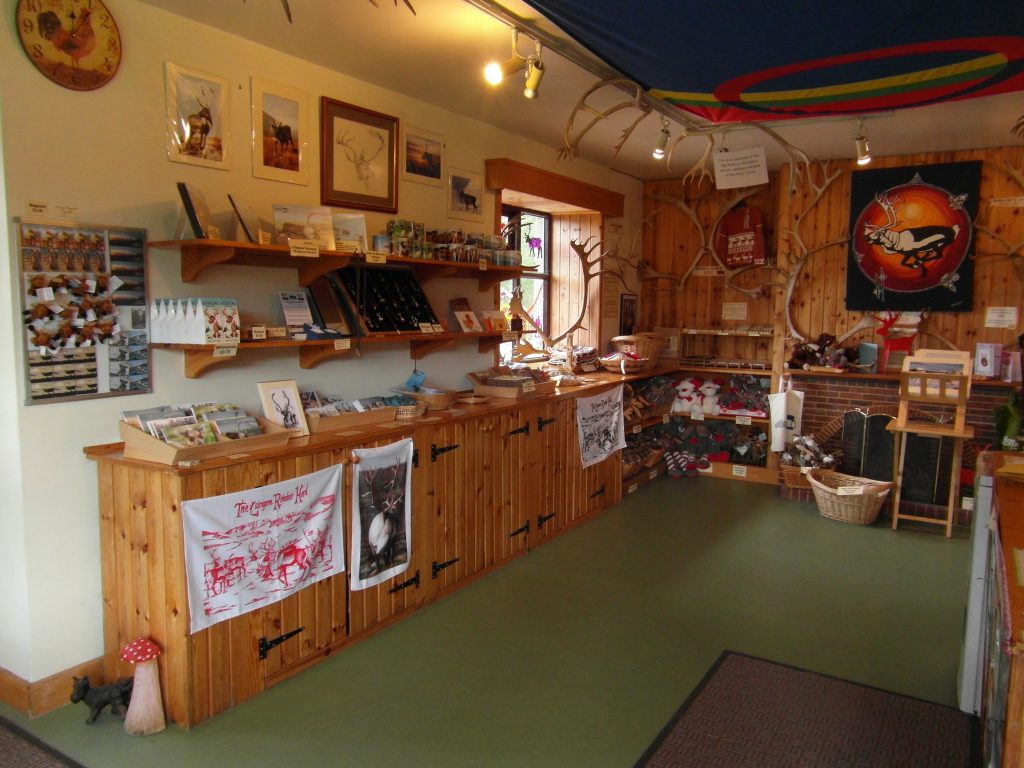
The first association that most visitors have with the Centre is when they come into the shop. This room is at one end of Reindeer House, and is where we greet visitors, book them onto tours, and provide a selection of souvenirs.
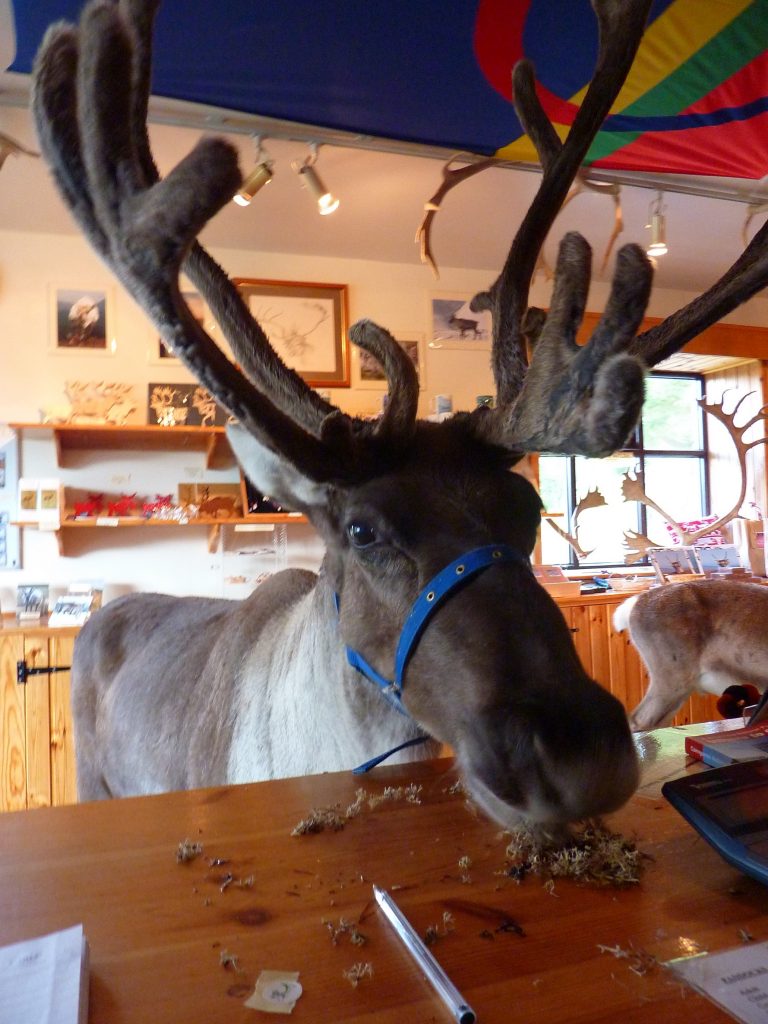
Back when Mr Utsi and Ethel Lindgren first built Reindeer House, this was the room where they entertained guests and had a wood fire burning to provide warmth and cheer. Sami artefacts and pictures adorned the walls.
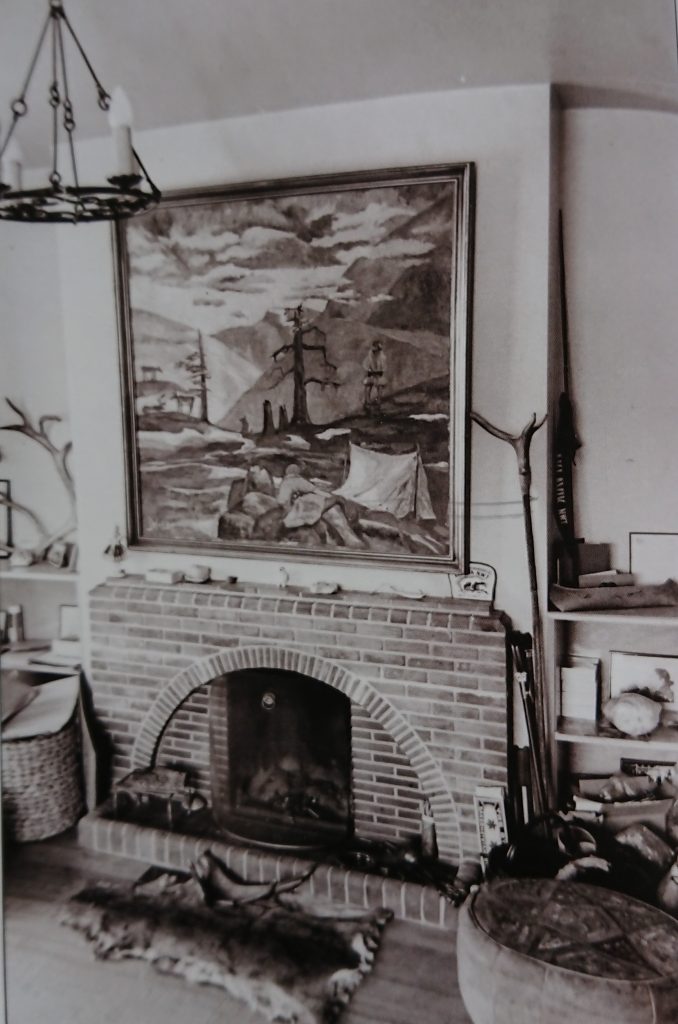
Nowadays our exhibition has outgrown the room and has moved to the Paddocks, and somehow I’ve inherited the responsibility of stocking the shop with (hopefully) interesting things to buy. The one rule that I was told by Tilly is that everything must be reindeer-related! We’re keen to keep it a bit different and not just end up selling the same souvenirs as every other shop, so I spend lots of time trying to track down locally made, unique products. It’s lovely to be able to support other small businesses based in the area by buying their products.
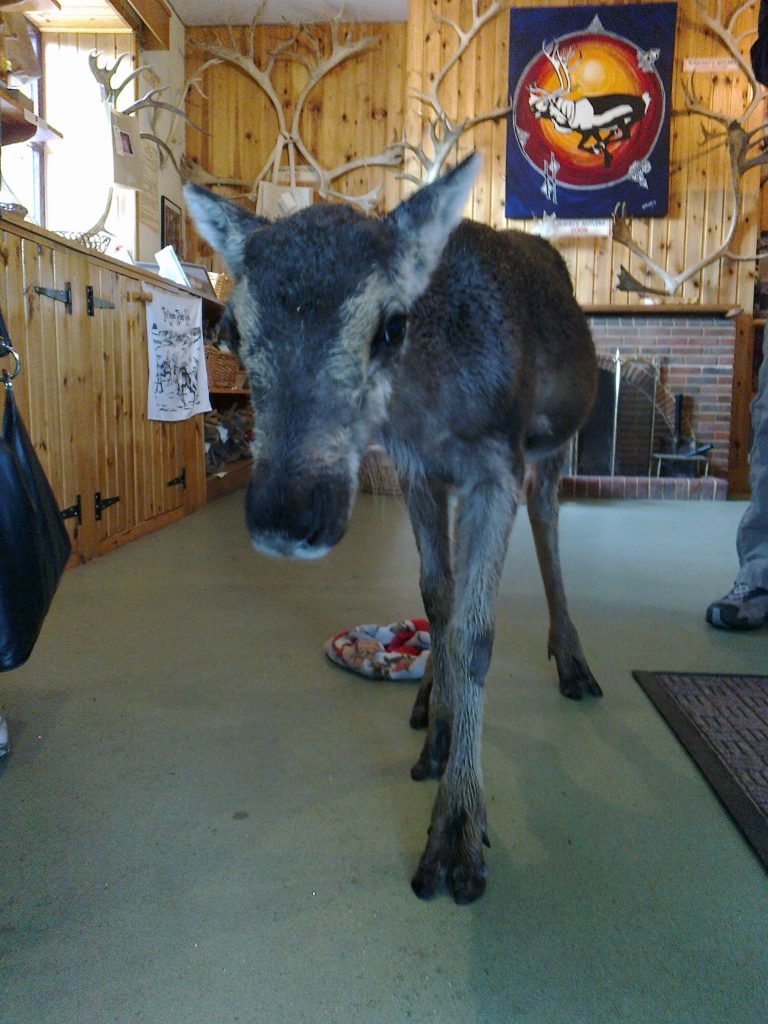
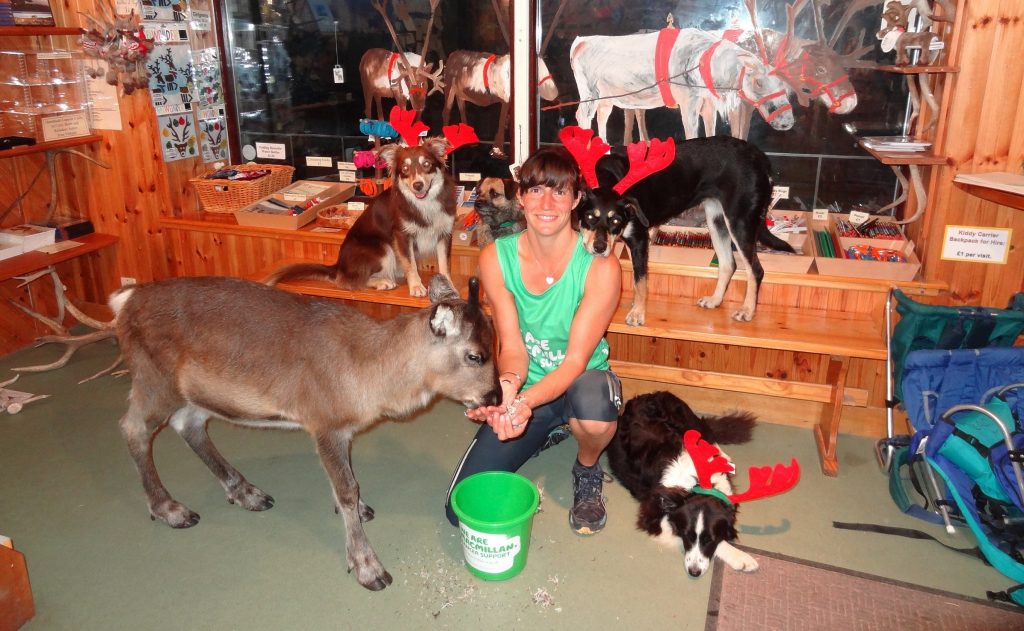
Some of the products are very local indeed – herder Fiona uses reindeer antler to craft jewellery, cheese slices and knife handles, and I dabble in tying fishing flies made using shed reindeer hair. A local photographer creates brooches and pendants with photos of our herd, and green wood worker ‘Wooden Tom’ makes model reindeer out of branches, complete with removable twigs for antlers. We’ve also recently started stocking a locally made 100% natural midge repellent, helpful for actually getting out on the hill to see the reindeer (I’ll make an argument for a tenuous link to reindeer!).
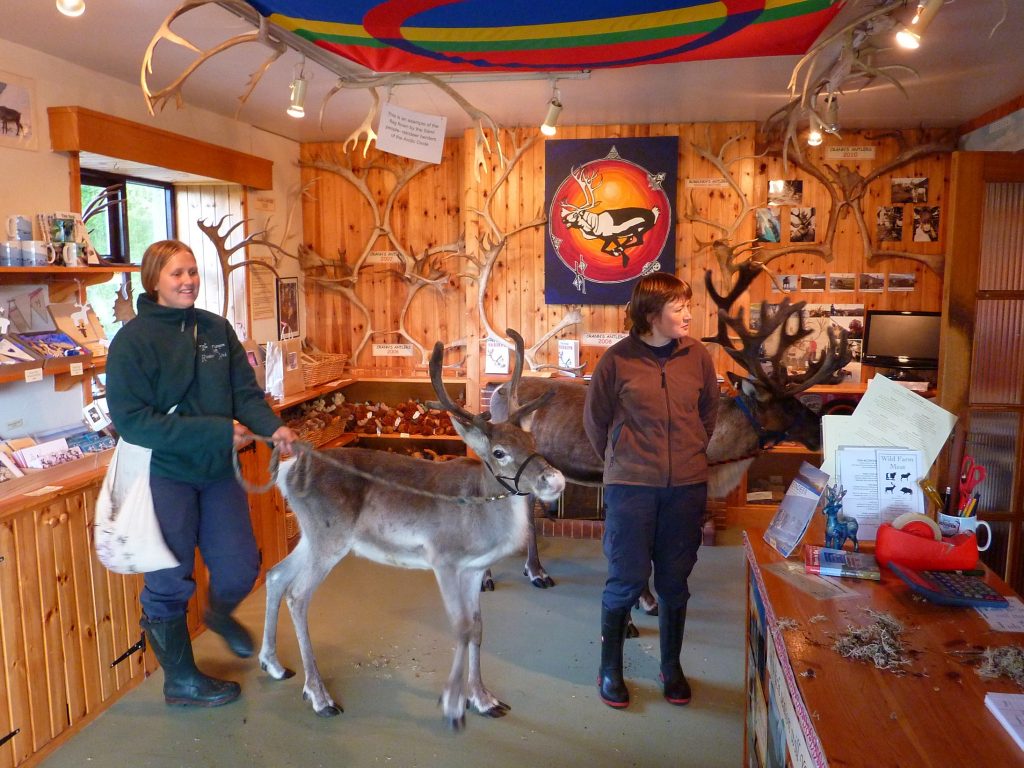
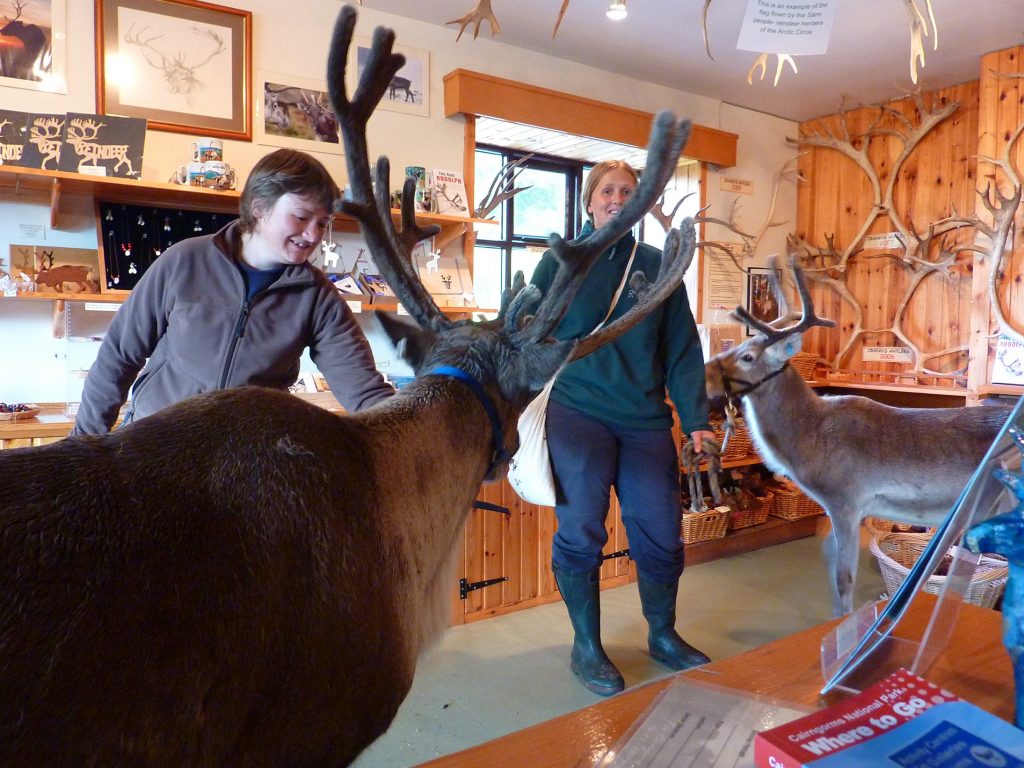
Being a bit of a bookworm myself, our book selection is pretty good – including several books written about the Herd, some more general ones about reindeer and the local area, and children’s books. Talking of children, everyone needs a soft toy reindeer, so there’s a choice including some more realistic options and others which focus on being cuddly and cute. It’s certainly the area many kids make a bee-line for, though there is a slight problem that some dogs that are staying with us (especially puppies) will also decide to help themselves if we forget to shut the door!
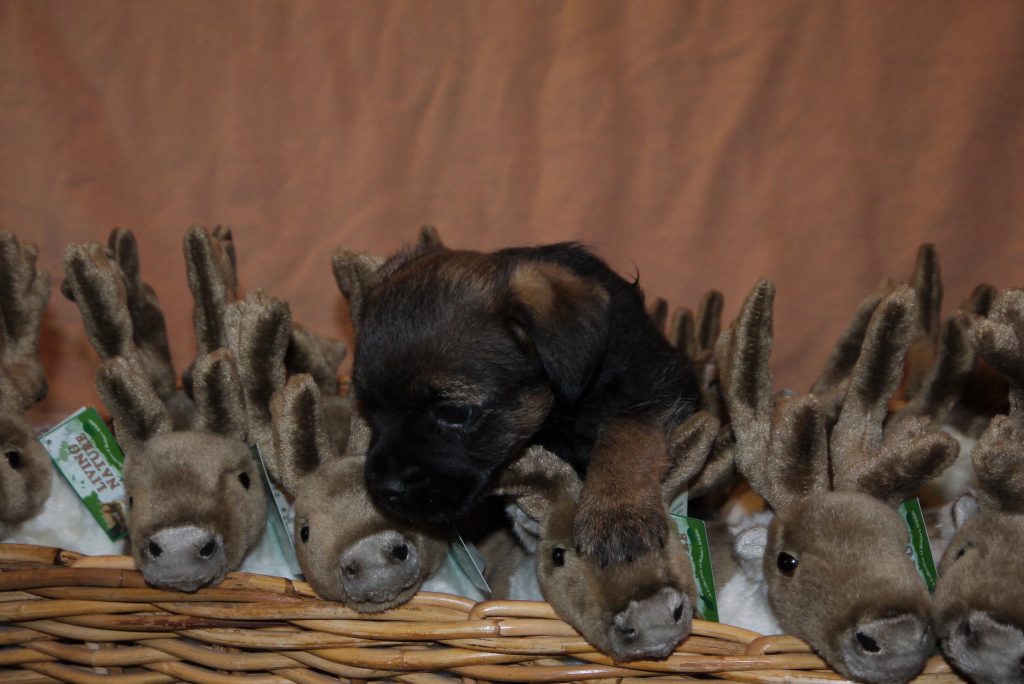
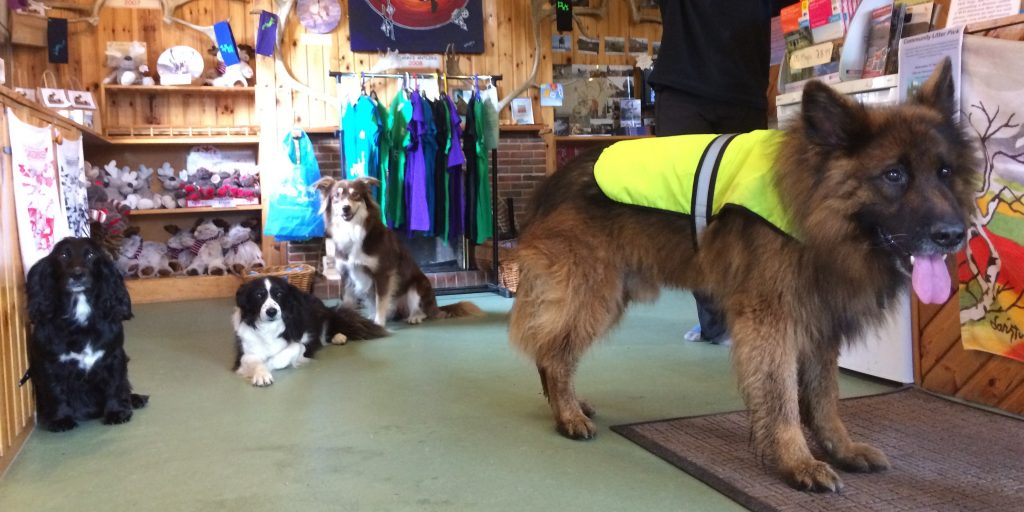
In January we take the opportunity for a deep clean, and also use the floor space for cleaning all our harness after Christmas tour. I do love a nice ordered system and usually commandeer this job!
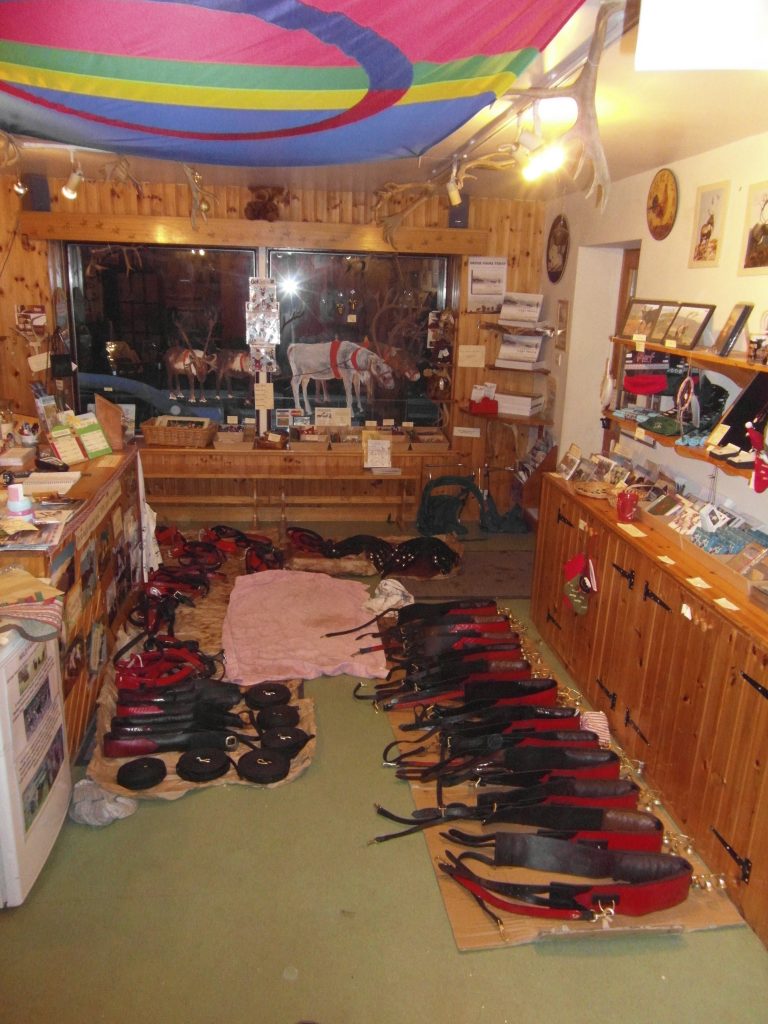
Reindeer House does live up to its name and many of the reindeer have popped into the shop for a few minutes over the years, mostly ones who were hand reared, but also the occasional one who is being trained – just as you expose a puppy to lots of situations to help make them confident and relaxed with whatever life throws at them, calmly introducing reindeer to unexpected scenario helps create a chilled-out individual! The only problem is that reindeer, with their amazing thick coat, often find it a little warm in there, and after a minute or two need to lose some heat, most quickly achieved by spreading their legs and having a pee!
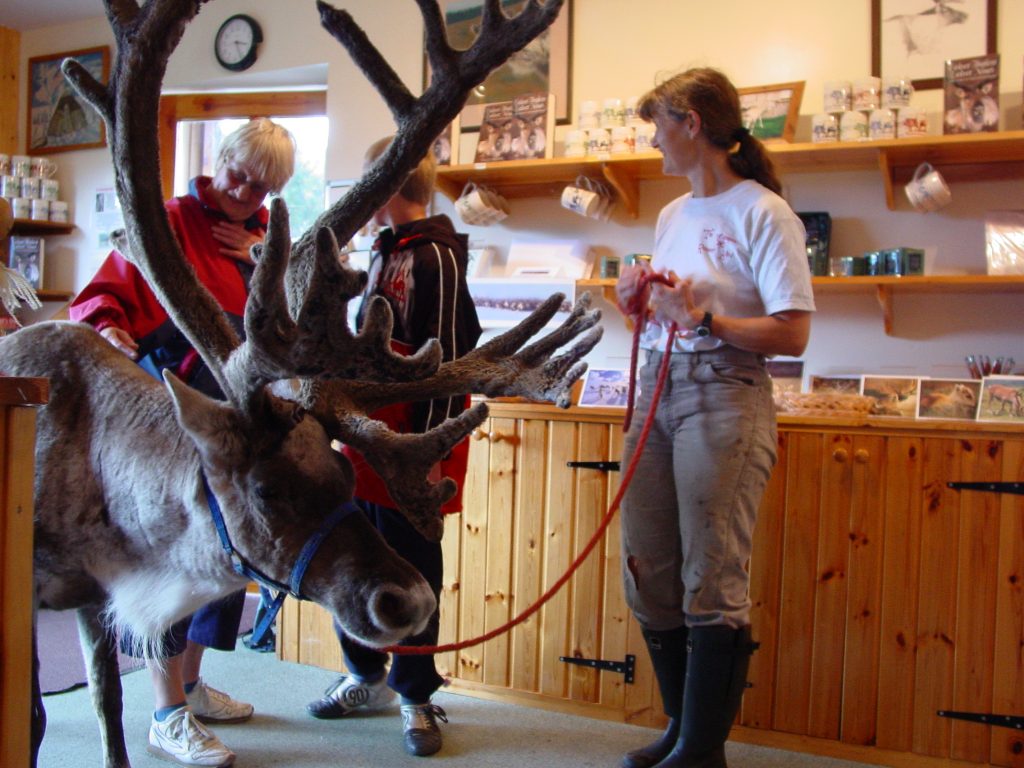
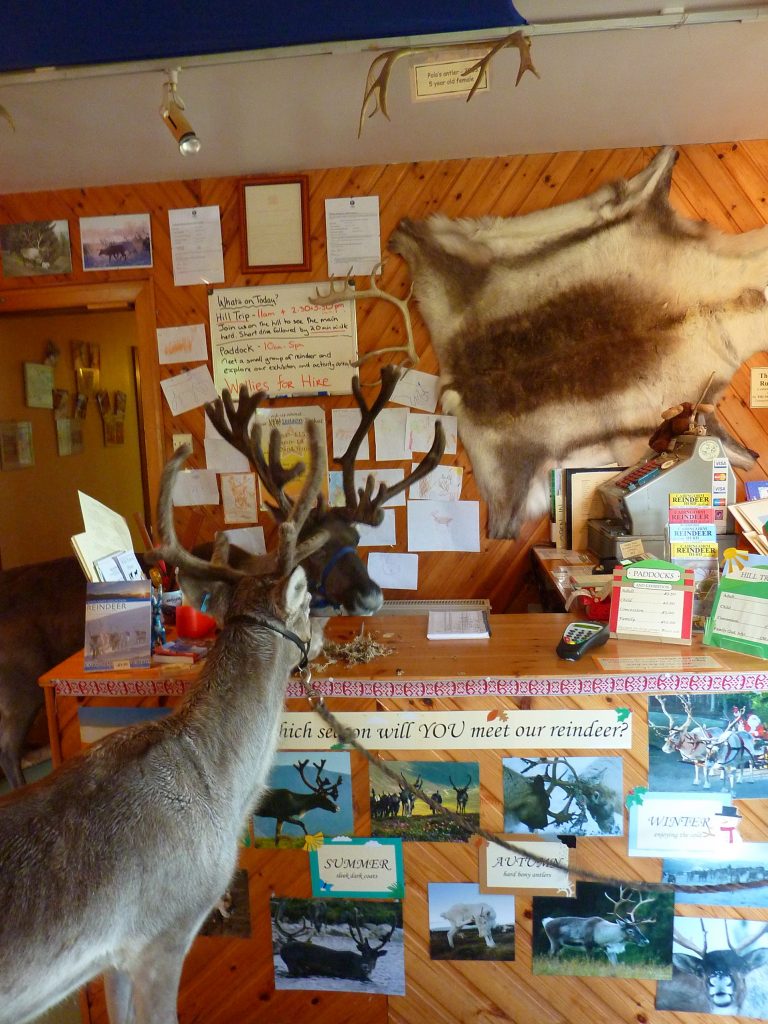
Andi
Another summer has come to an end and we have had to say goodbye to Julia once again. Her parting gift to me after her fourth summer working at the Reindeer Centre was lots of lovely photos to make up a couple of blogs out of. Julia is a talented photographer so I hope you enjoy her photos from this summer. See you soon Julia, we miss you already!
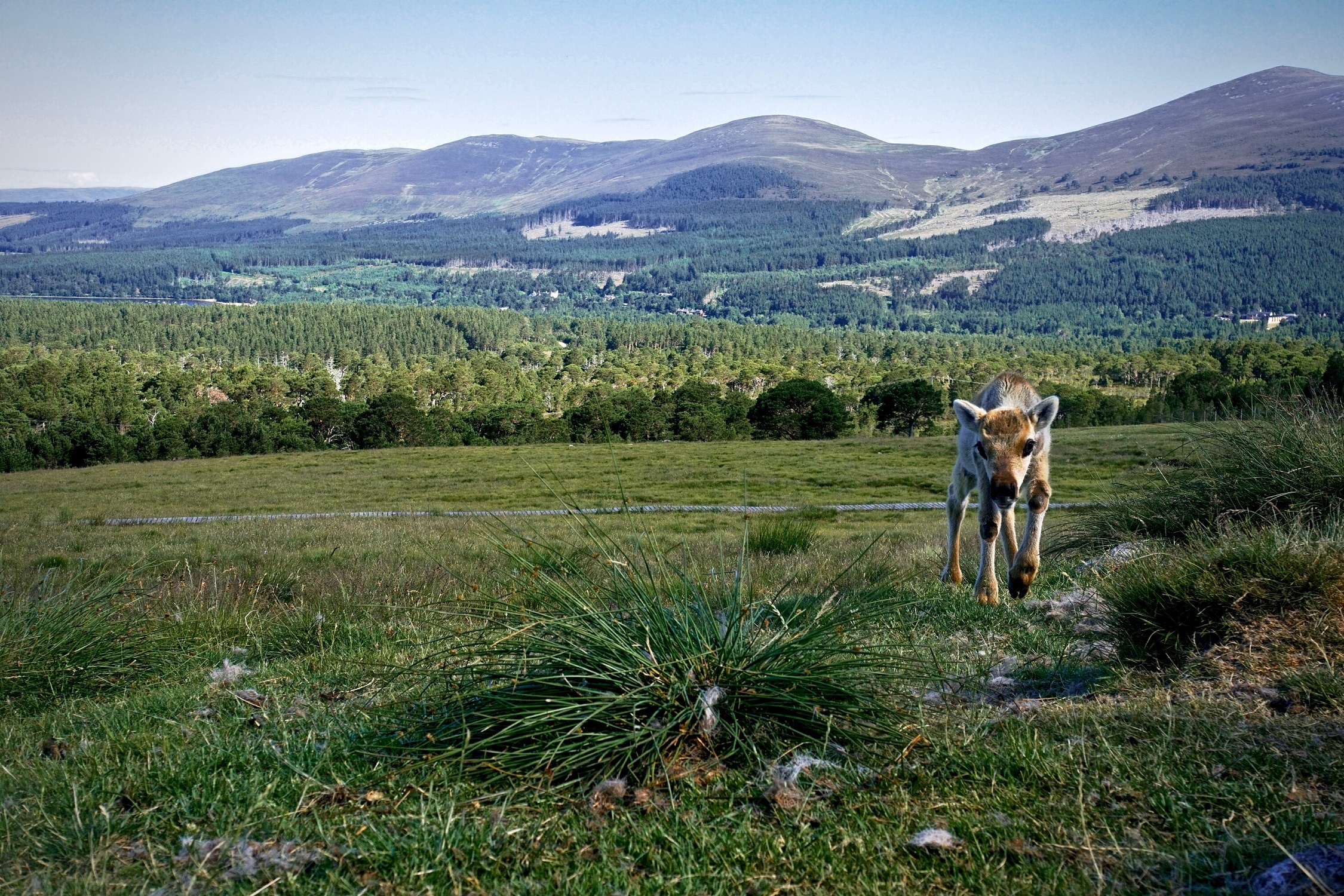
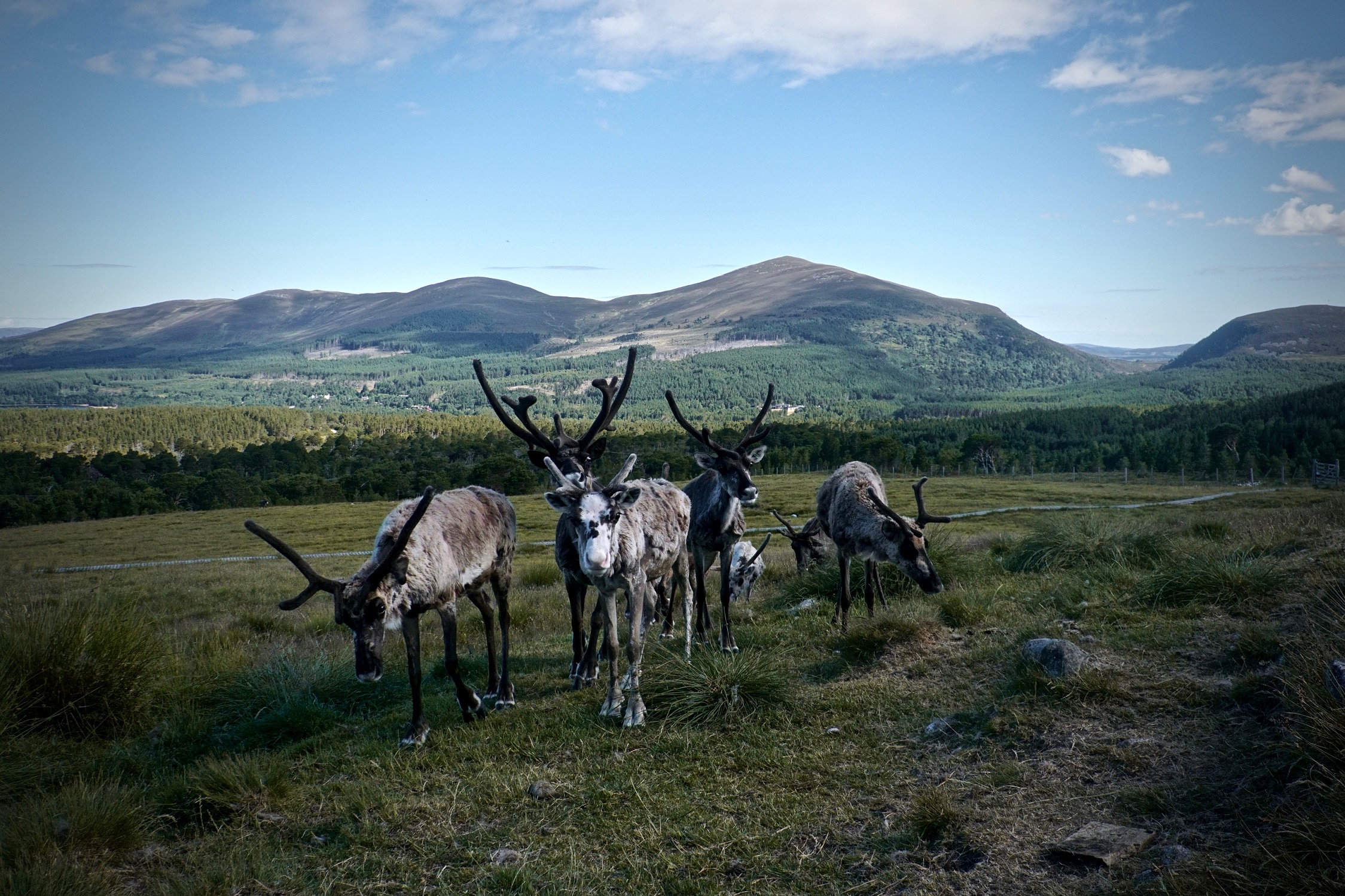
04/07 (2) The reindeer gang with Pict leading. They were all on their way to the shed but were a bit wary of me, stopping just for a second before heading into the shade to escape the hot sun. At this point in the summer we had the most amazing hot, sunny weather which was sometimes a bit too hot for the reindeer!
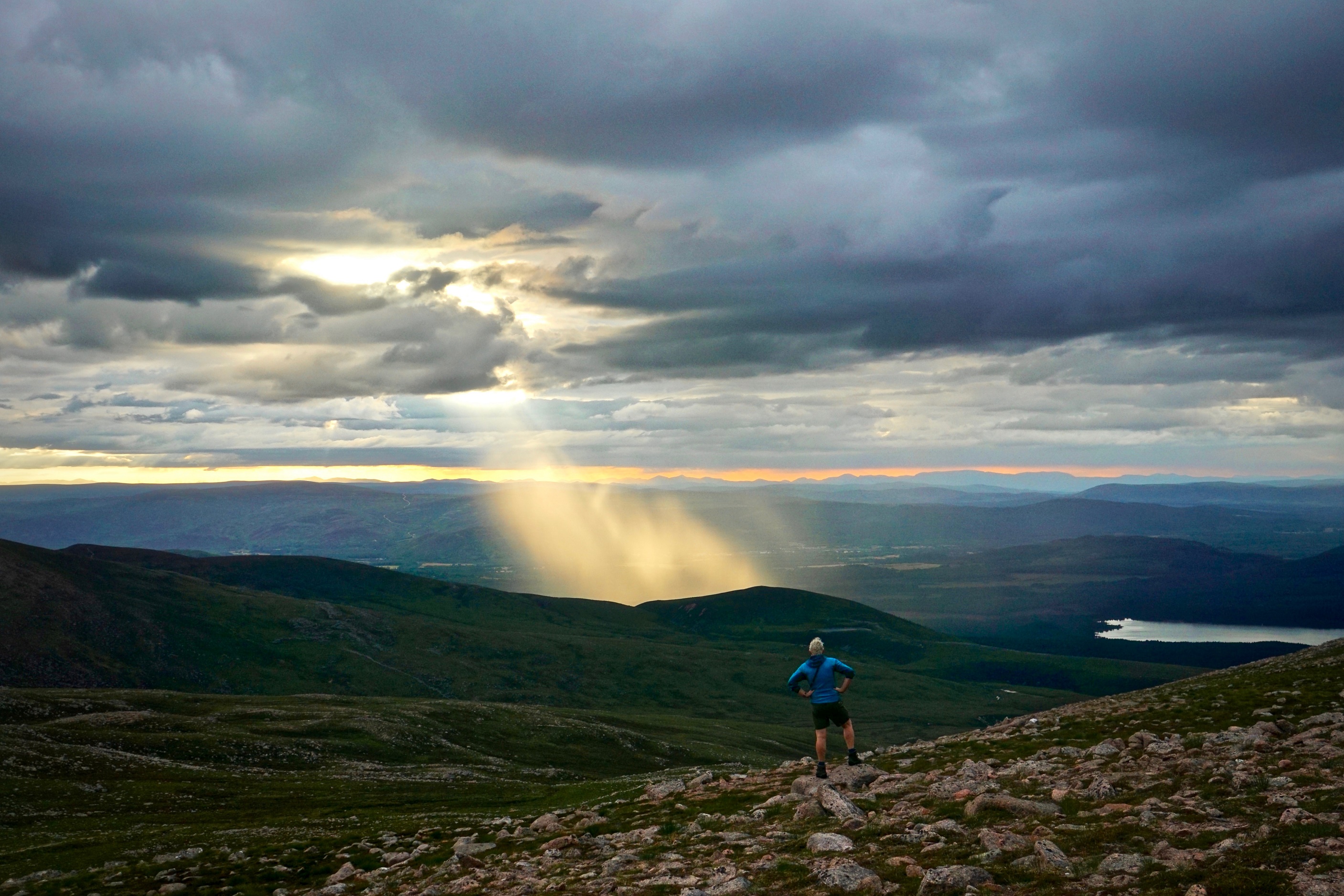
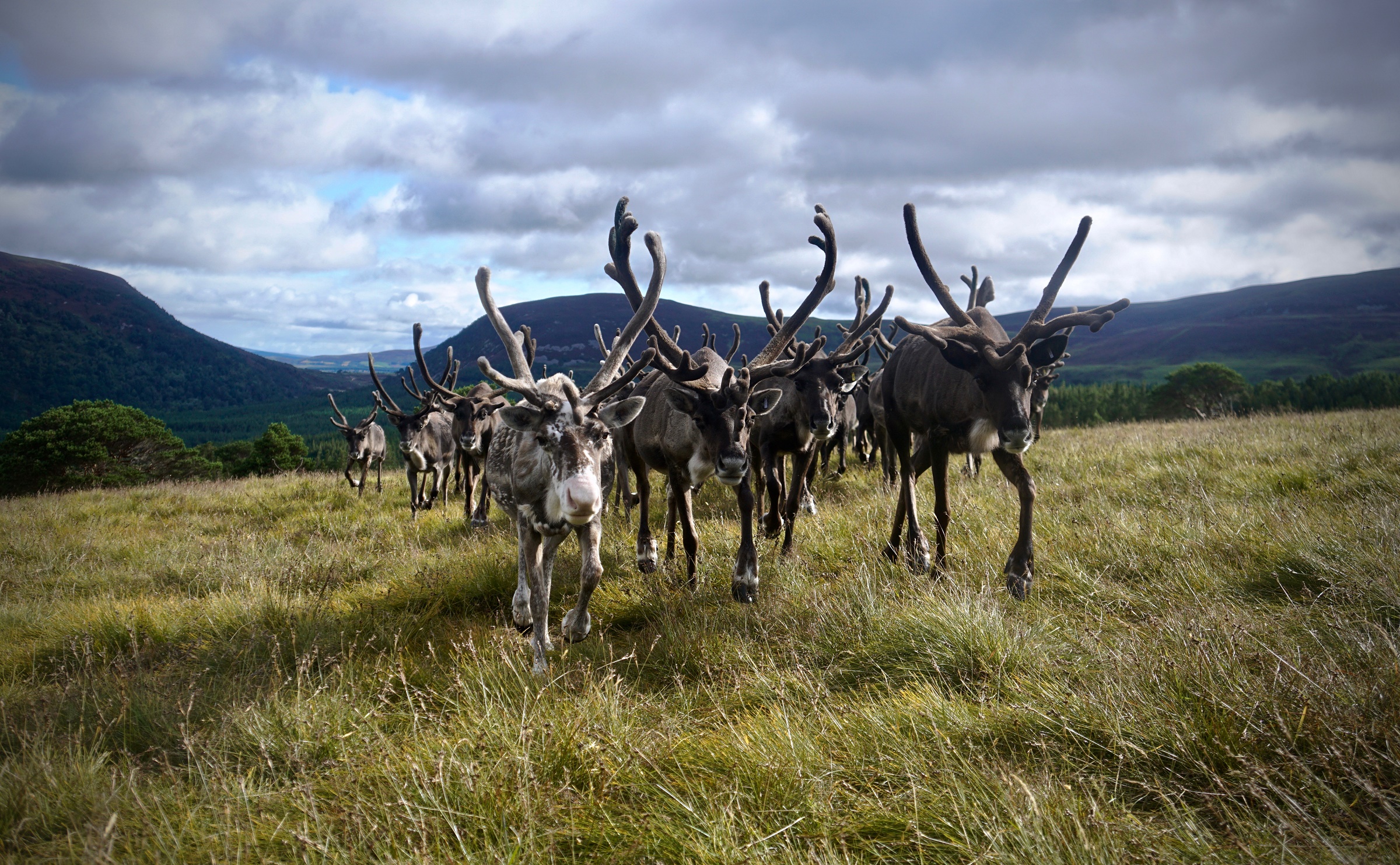
23/07 (1) The herd running for their breakfast. (left: Mo, centre: Atlantic, right: Baffin).
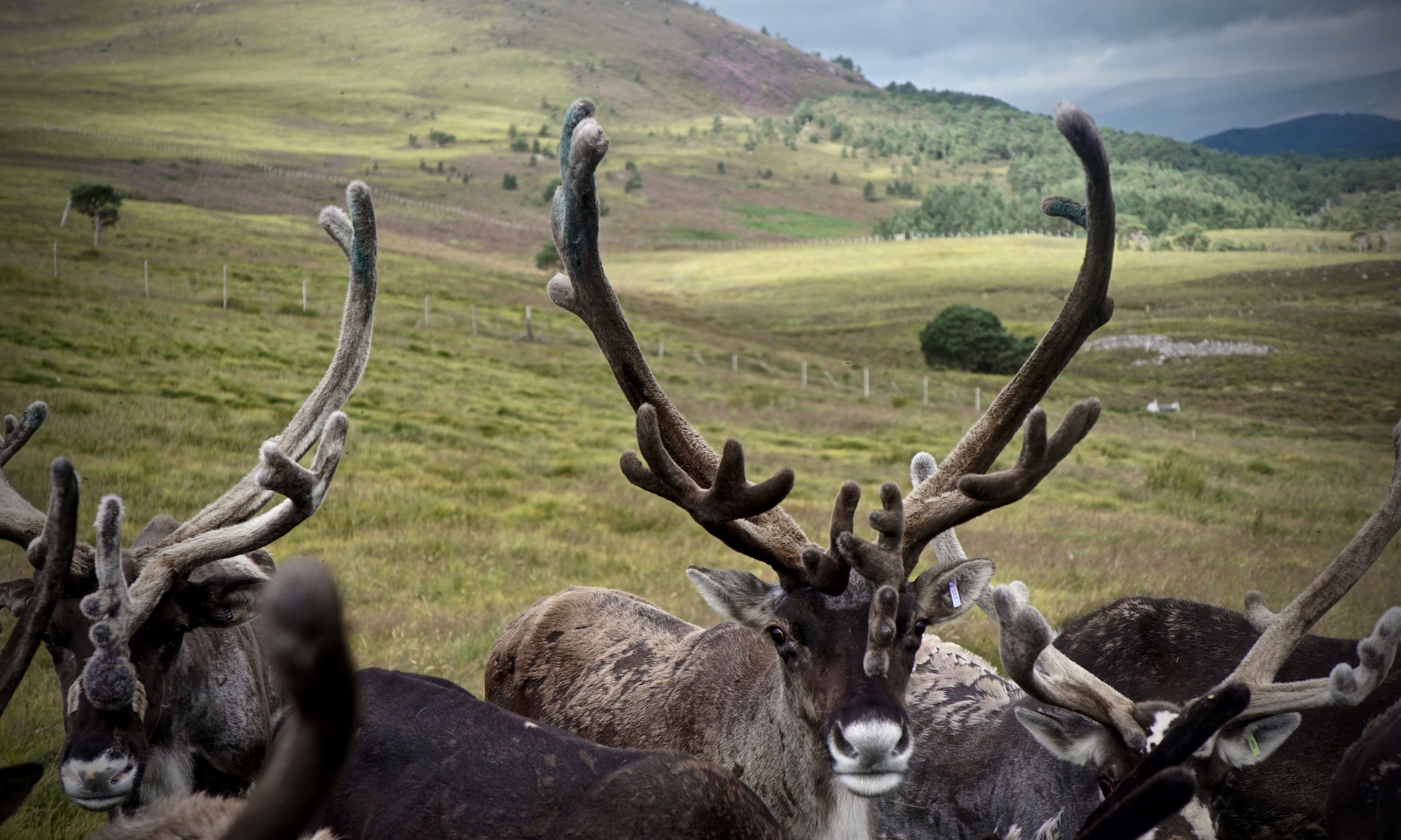
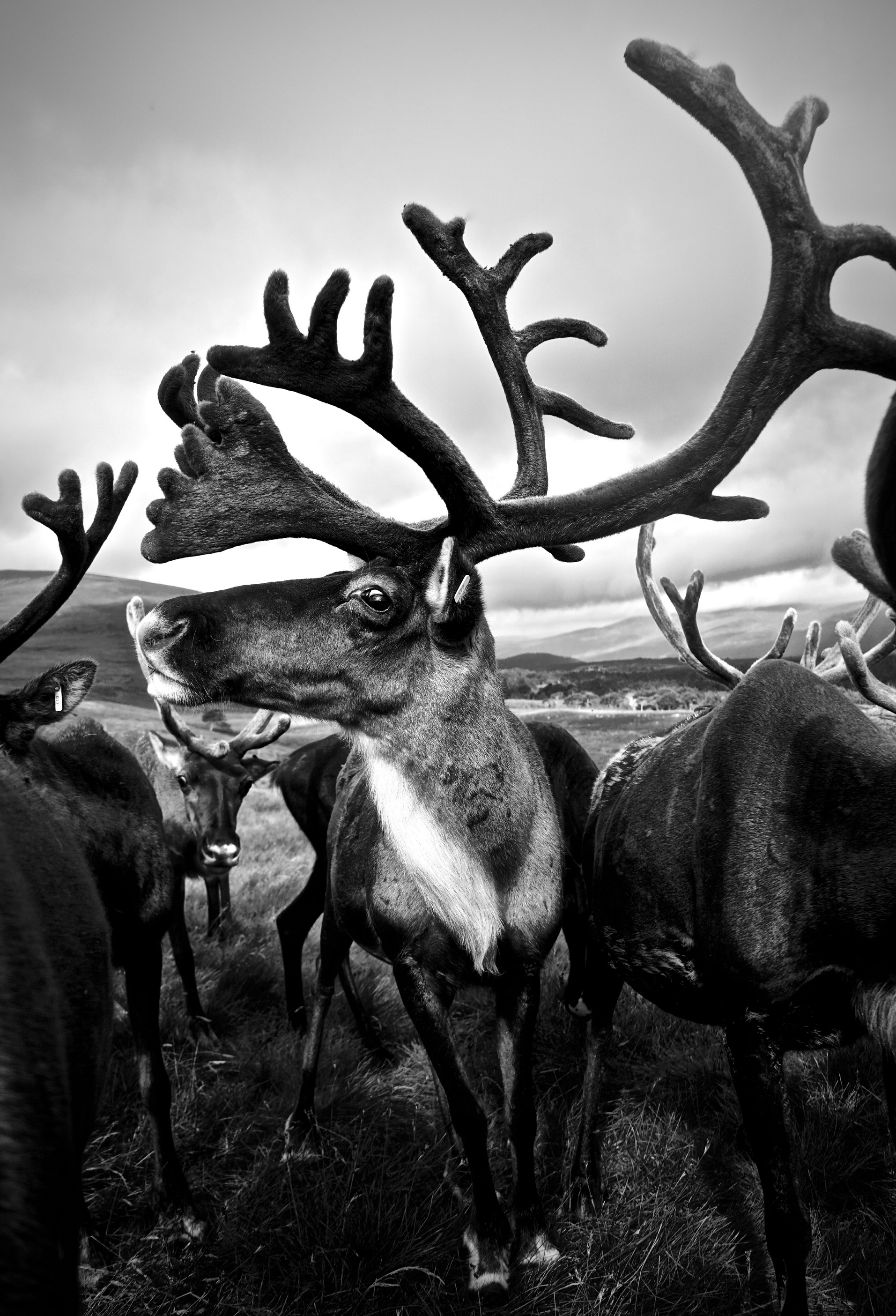
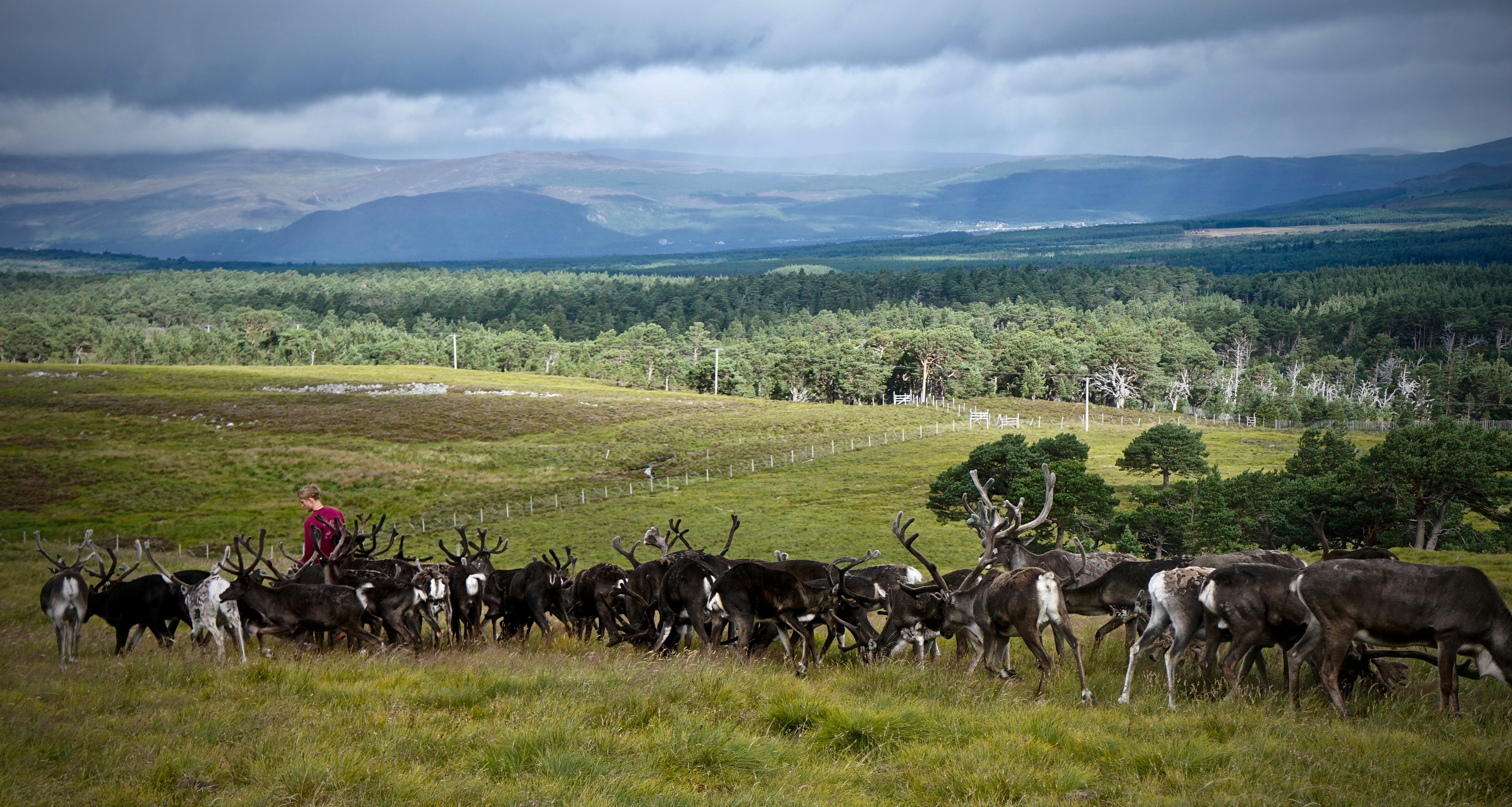
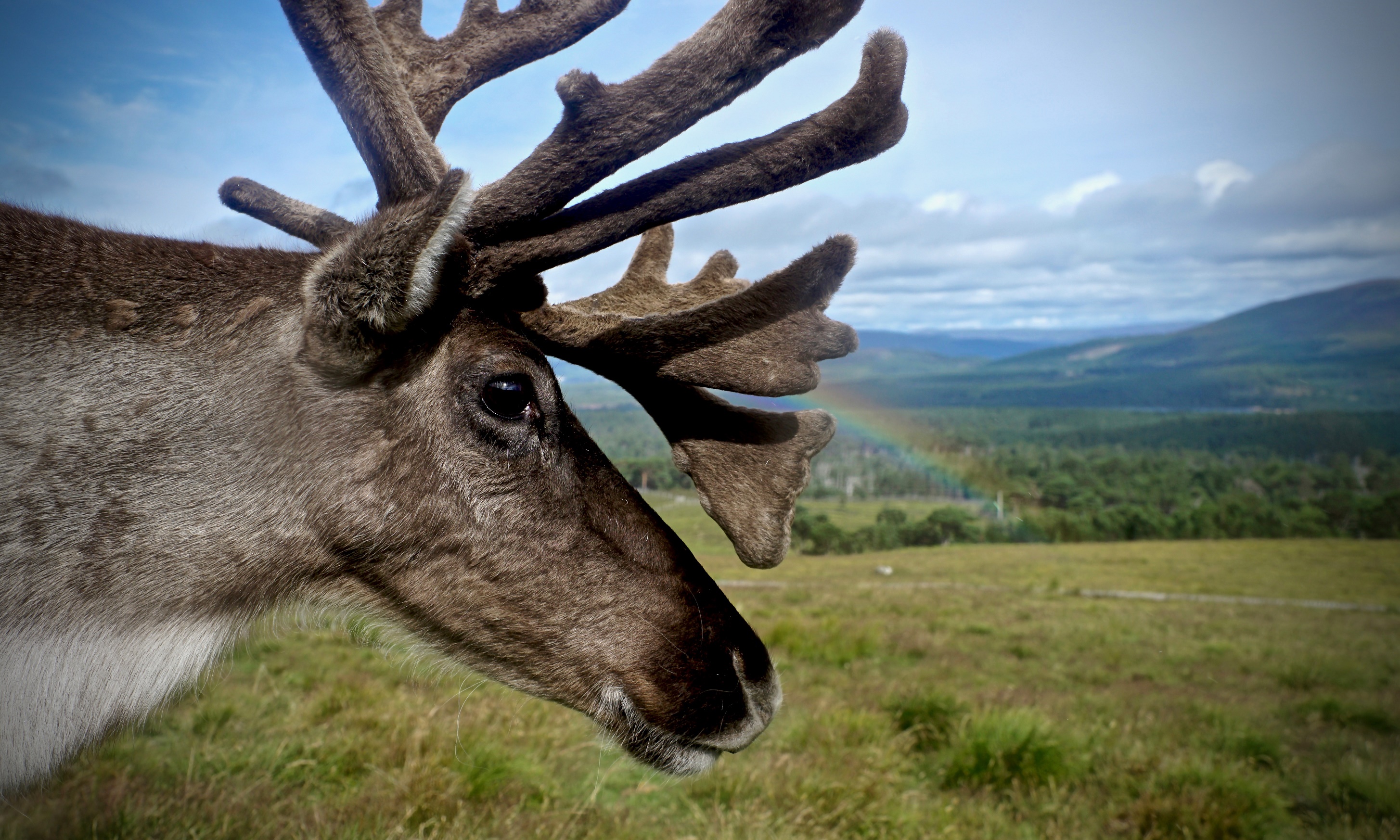
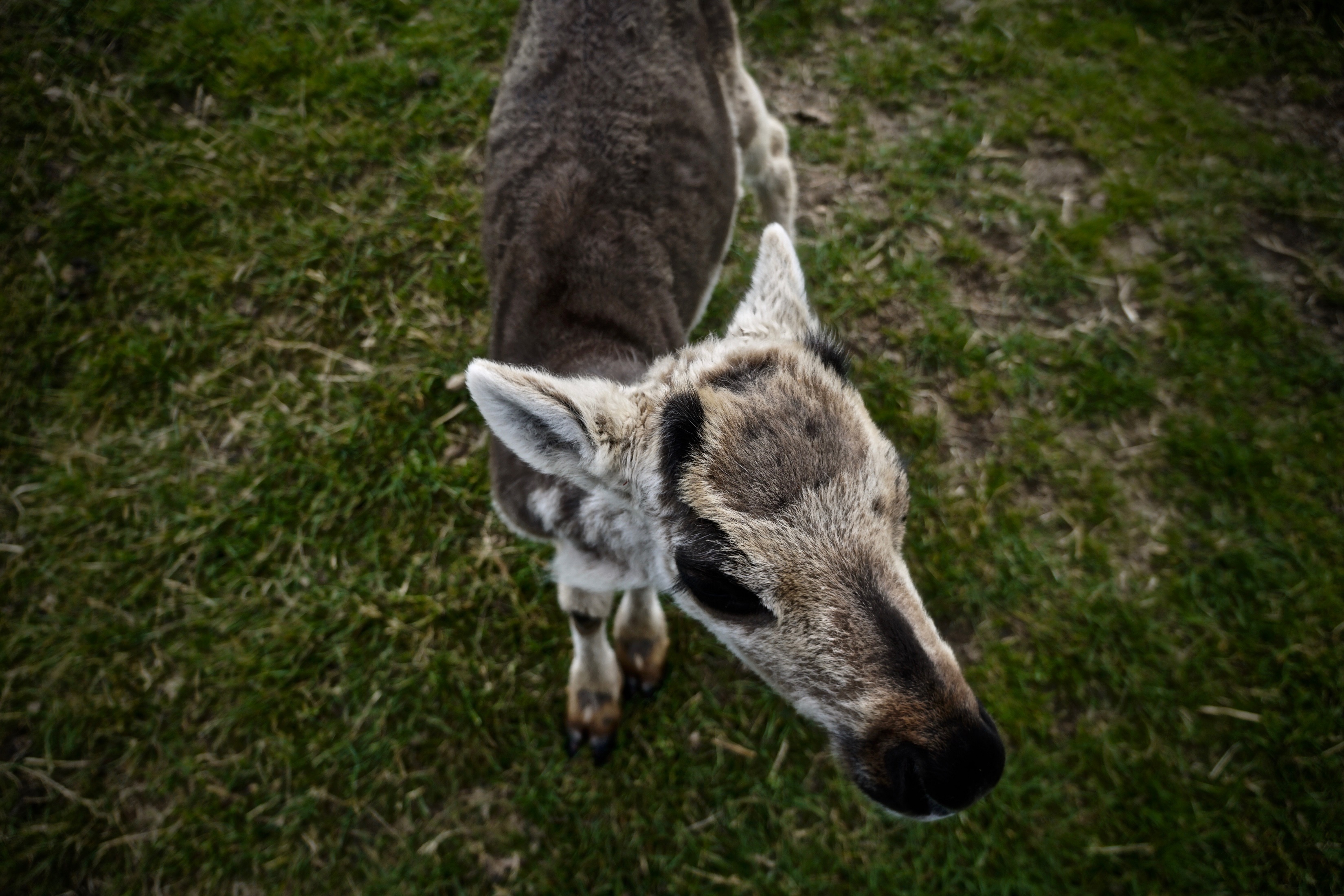
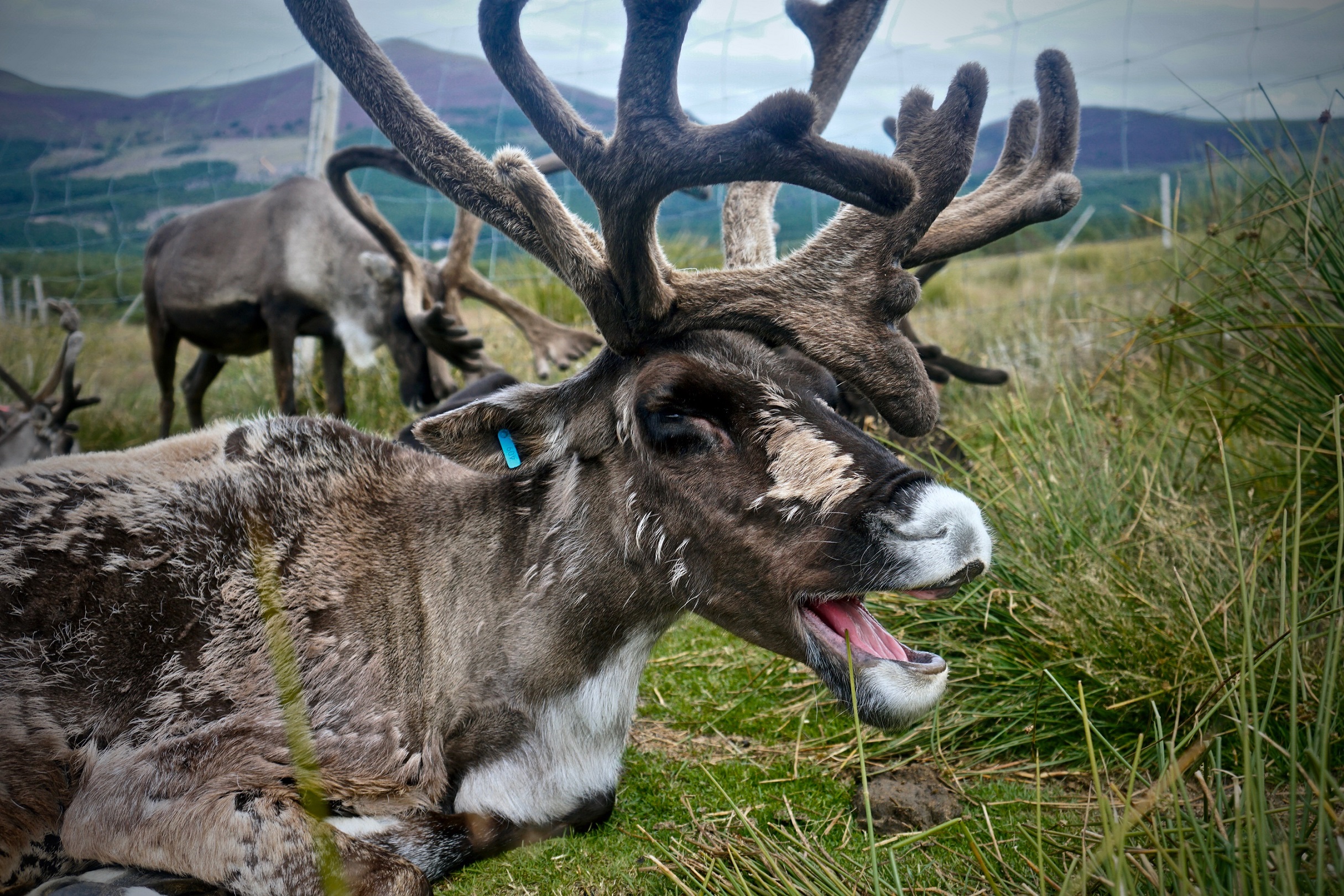
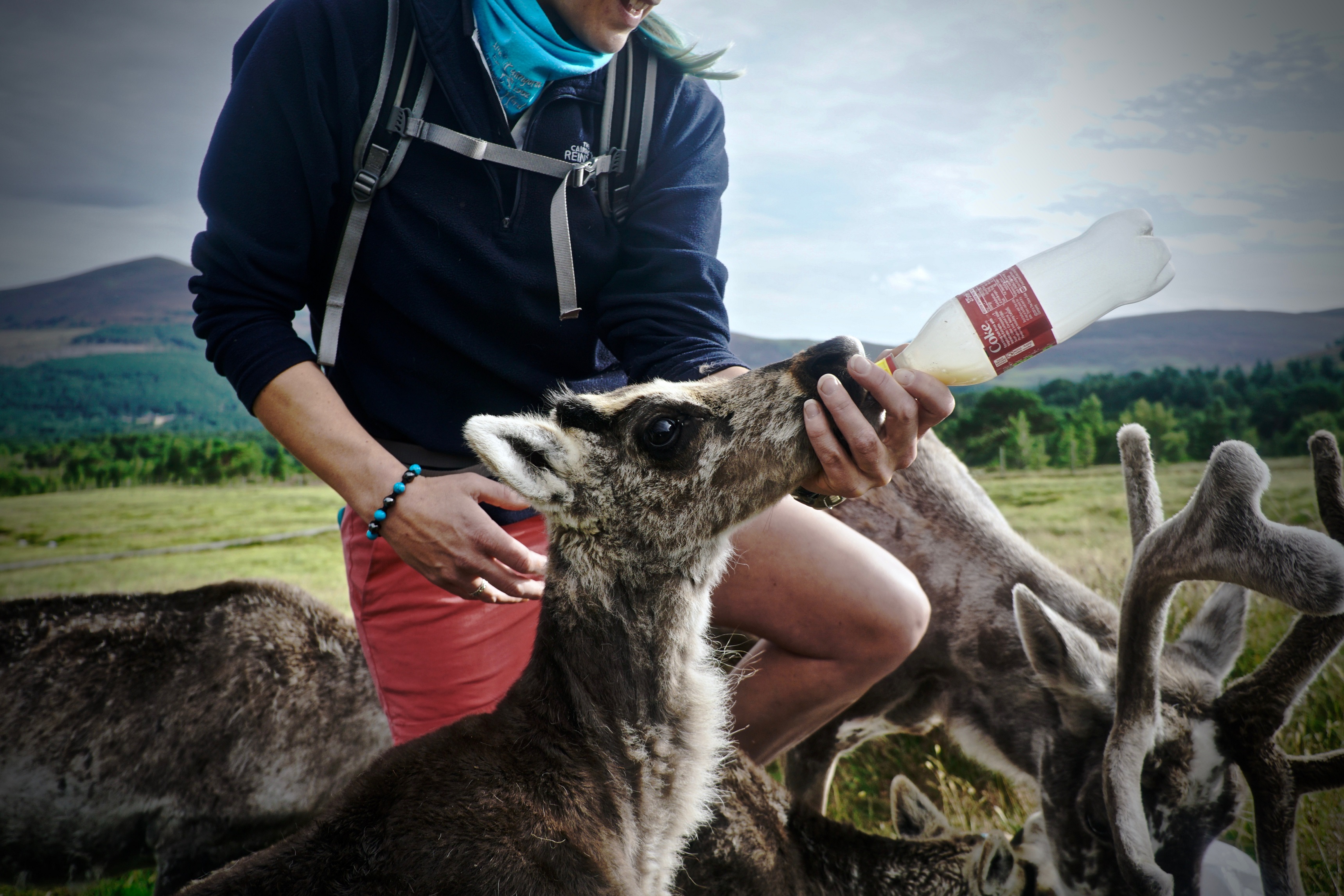
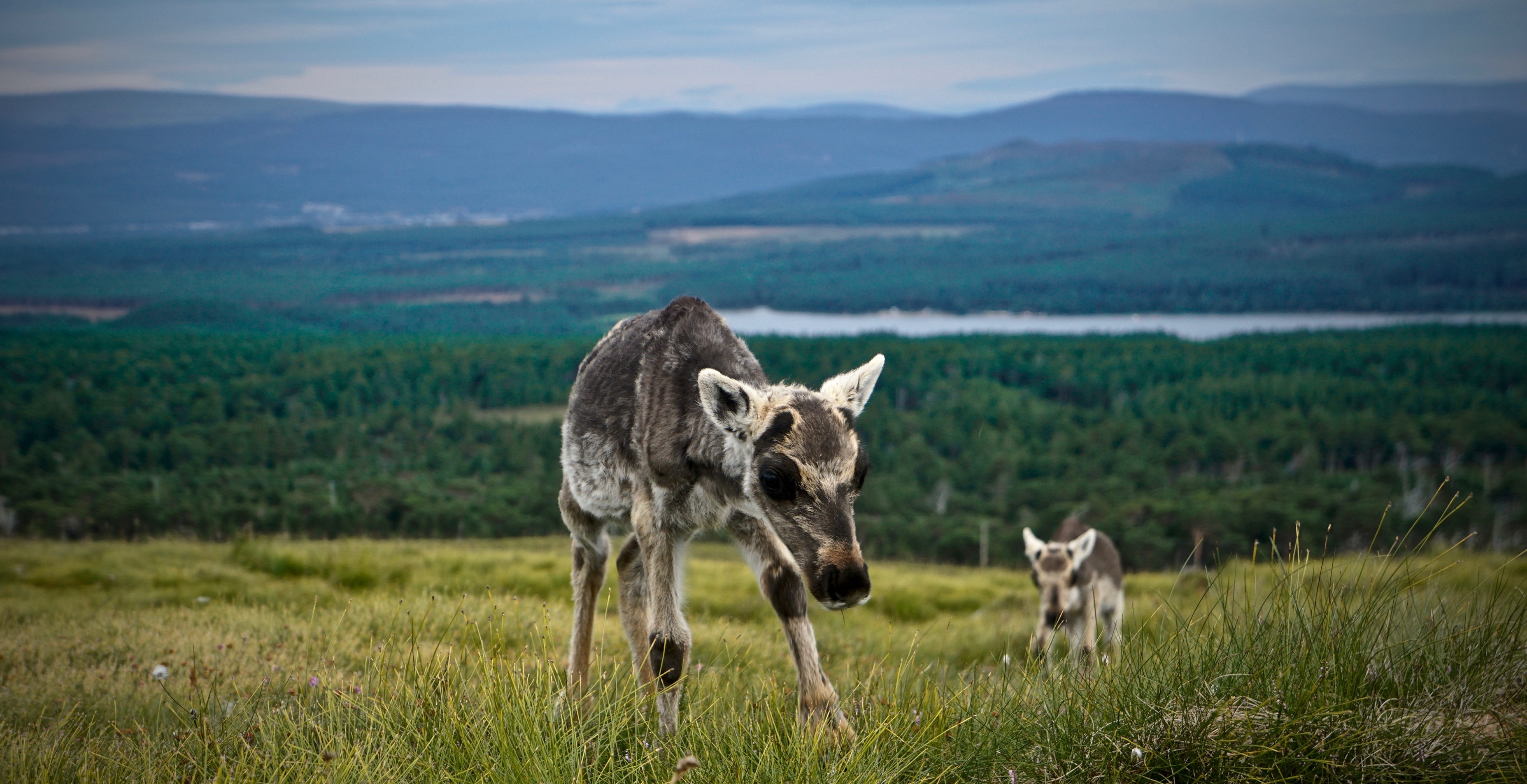
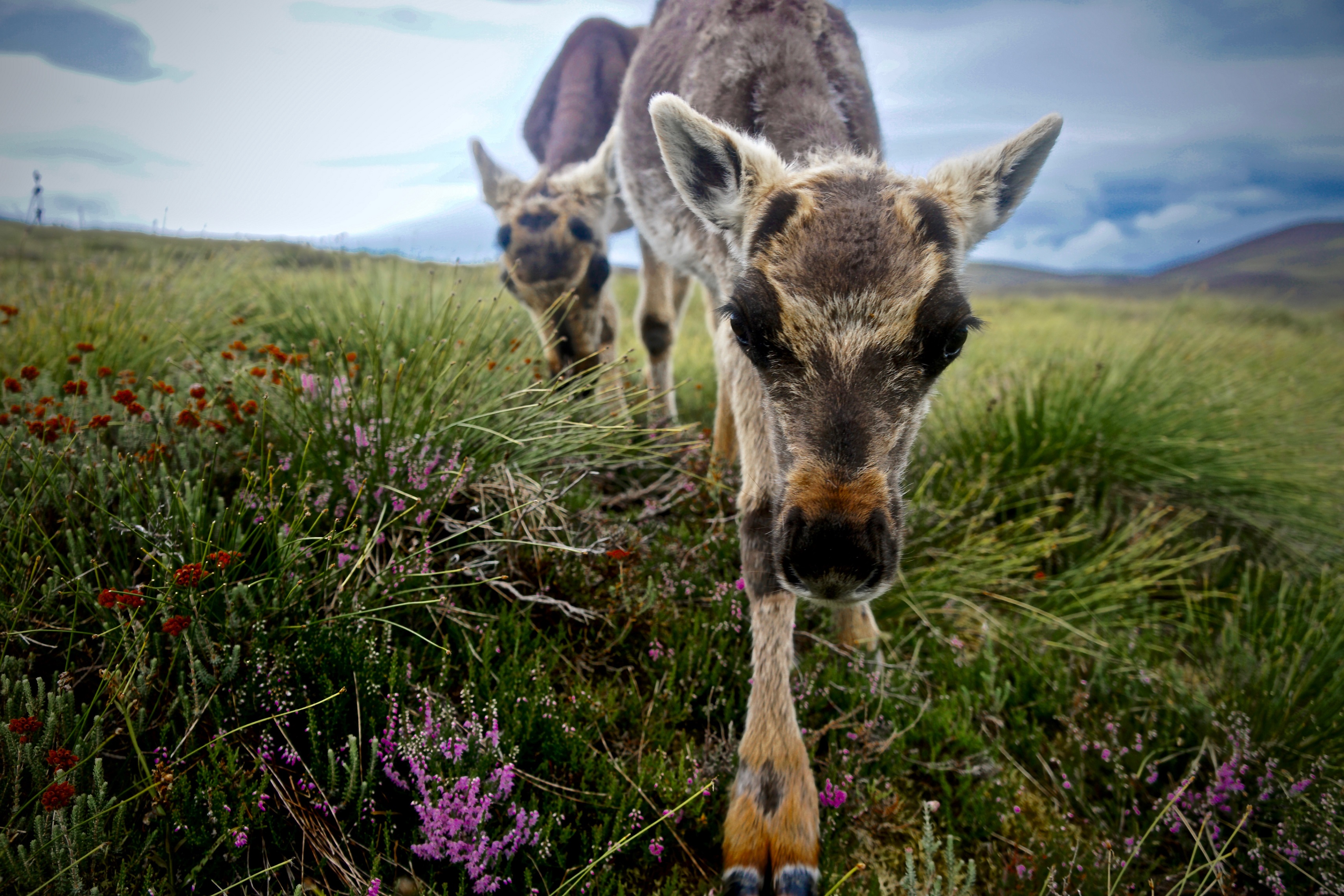
Since it was quite the internet sensation, we’re assuming most of you may have heard about the disappearance and relieving retrieving of Sookie, our in-house dog at the Reindeer Centre. Many people helped in the search by sharing our story, looking out for her, sending us tips and reports, and by offering us help in all kinds of other ways. With this blog we’ll give an overview of the timeline of Sookie’s wee adventure, and take the opportunity to thank everyone involved in the search!
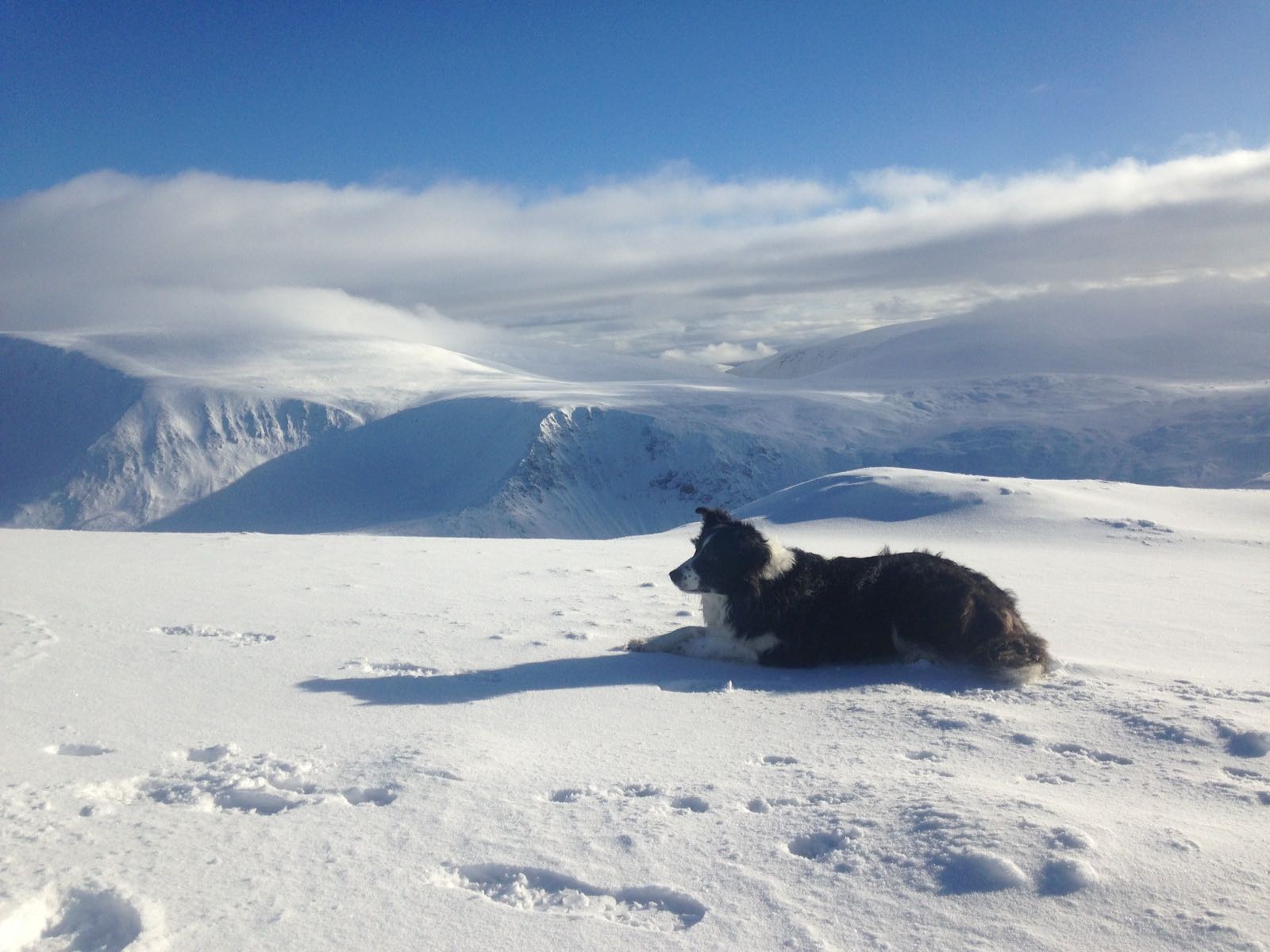
It was a nice Monday morning when one of Sookie’s favourite hill walk partners Mike pulled up in the driveway next to Reindeer House to collect her for a good day in the hills. He had planned to take Sookie up the munro Ben Lawers that day, which is a munro he’d walked before in his challenge to climb all of the munros. Once there they set off, near the summit of Beinn Ghlas, Sookie got a whiff of a smell of some kind of wildlife and took off. Mike, having walked Sookie many a day in the past, was not worried in any way, as she does so quite often but always returns shortly. This time however, it took a wee bit longer than usual for her to return..
After eating his lunch, waiting for her and calling for her for some time, Sookie still hadn’t returned. Mike decided to walk back to the carpark, hoping she’d be there, but unfortunately this was not the case. Mike climbed up the hill again, but still no Sookie. After it got too late to look for her, he stayed in his car overnight at the carpark, and we hoped she’d turn up the next day.
Tuesday morning there was still no sign of Sookie, either at the carpark and or on the mountain itself. The next few days, different search parties consisting of herders, friends, and volunteers, went to the area and came back with no luck. On Wednesday, Robert McComb, an incredibly nice man who had contacted us via Facebook, made his way up from as far as Glasgow to help us out with a drone! Unfortunately it was too cloudy to be able to see a lot of the area with it. Then throughout Thursday, the Reindeer Centre got 4 calls from people who’d heard barks in the same area near Loch Tay. The people at the Centre marked off an area on the map according to these people’s reports and the search continued, along with other herding dog Tiree who might be able to lure Sookie out with her barks or find her by smelling her. While the barks were heard again, it was too dark and too far away to find her. The next morning, Friday, which was already 4 days after she’d been last seen, the barking was heard again for some time, and eventually the Centre received a phone call from local ranger Andy. Sookie had turned herself in! Full of ticks, slightly underweight rather than covered in her usual bit of bodily winter reserves, and completely and utterly exhausted, was she returned to us. I was the lucky one to be in the area around that time, and had the delightful experience of driving her back to the Centre, where all the herders got quite emotional reuniting with her. Sookie’s doing well in her recovery. She’s slowly gaining weight and liveliness, and is certainly very happy to be back.
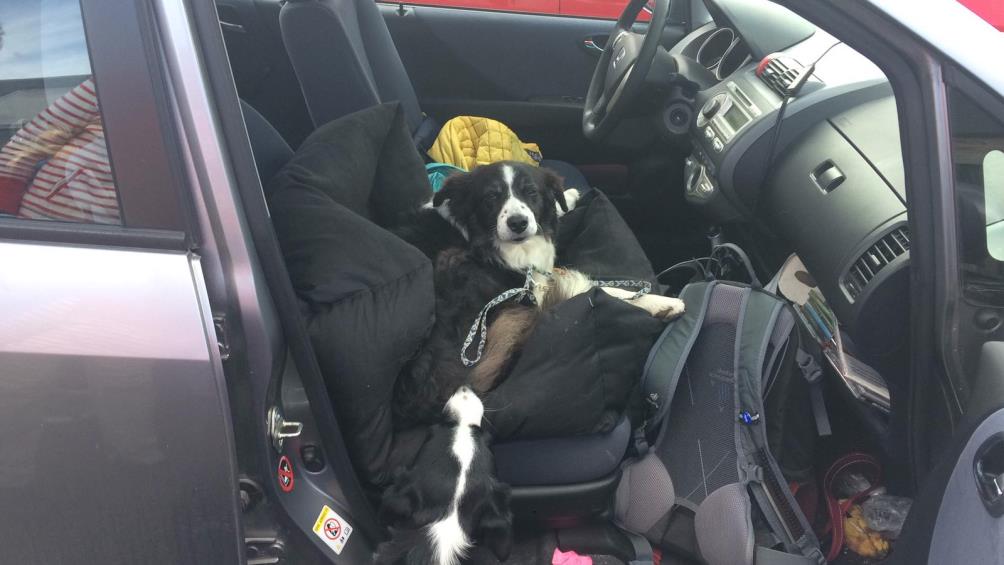
We would like to thank everyone who has shared our Facebook posts, everyone who has offered to help us search for her, everyone who has wished us well, and everyone who has shown support in any other way. We were overwhelmed by all of your kindness. We would like to express special thanks to Andy, the ranger who contacted us and reunited us with Sookie, and to Dicky and Raina, the people who managed to hold on to Sookie after she’d shown up on their land, and who then contacted Andy. We’d also like to express thanks to Christine Parkinson, who offered me a place to stay on Thursday night to make the search easier, to Graham Jones who was out searching with his dog Mack and of course to Robert McComb, who helped out with the drone.
Manouk
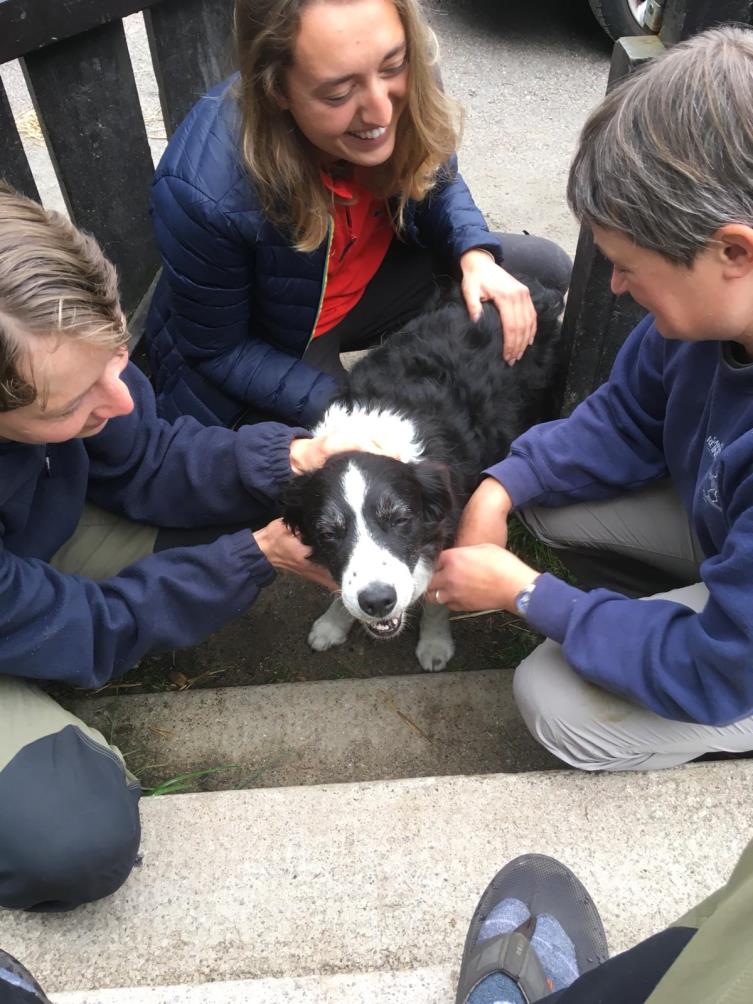
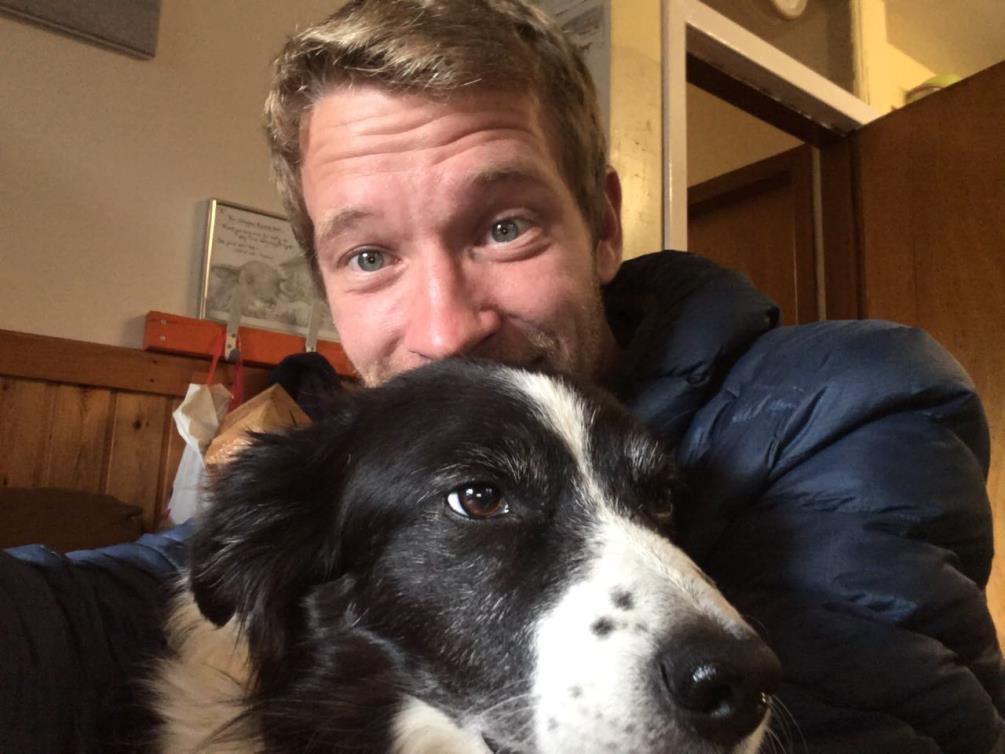
For part two of my Quirky reindeer feature, it’s the boys turn. Here’s a link to the girls in part one if you missed it last month.
Boris:
Mr Wonky Nose was born a little bit squint. From when he was a calf Boris has always had a slightly wonky nose. Apparently its from when he was growing in the womb he must have been pushed up against one side, only allowing the other side to grow normally. This has in no way affected him in a negative way, he’s just not the prettiest of reindeer. Though I know lots of people who would argue otherwise so I think in this case beauty is in the eye of the beholder! We have one other reindeer in the herd with a slightly wonky nose and his name is Addja. He joined us from Sweden in 2004 and is now the oldest male in the herd so this shows there is no negative implication.
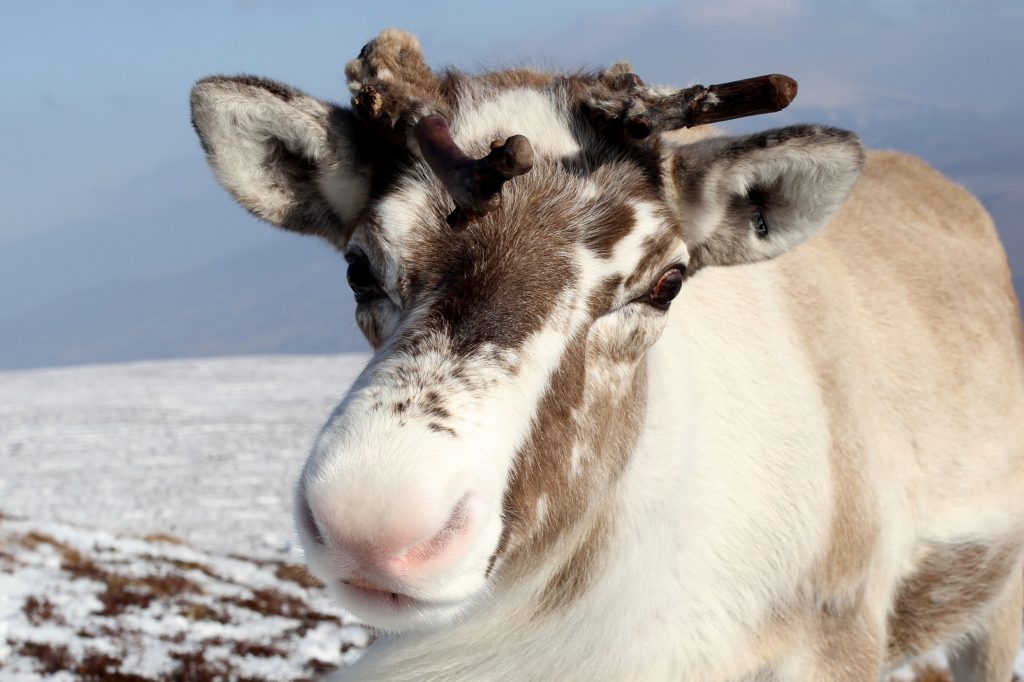
Atlantic:
Where most of my ‘Quirky Reindeer’ stories are of reindeer who have been born with something different, Atlantic fits into this story from something that happened to him a few years ago. He has always been one of the biggest reindeer in his year, growing lovely antlers and always in fantastic condition. Two years ago, while out on the winter free range on the Cromdale Hills we were catching up and checking the herd and found Atlantic with a very sore foot. It was so sore he couldn’t put any weight on it at all and he was going around on three legs. We immediately took him off the hill to our farm to treat as we didn’t want to risk losing him out there. The vet came numerous times to check him over, we administered various different antibiotics and cleaned his foot trying to get rid of the infection, however, the infection was so bad and right up in the joint of his toe of one of his front hooves that nothing was working. Having done our best his foot still wasn’t getting better so our local vet suggested we remove his toe. He said he has done this on cattle before and being cloven hooved (two toes per foot) they get by fine with just one toe. So it was decided, we would remove one of Atlantics toes and he has never looked back. In 2017 he was one of our main breeding bulls and he remains one of the biggest in his year. It just shows how animals, and humans, can adapt to a new situation and their quality of life doesn’t need to change.
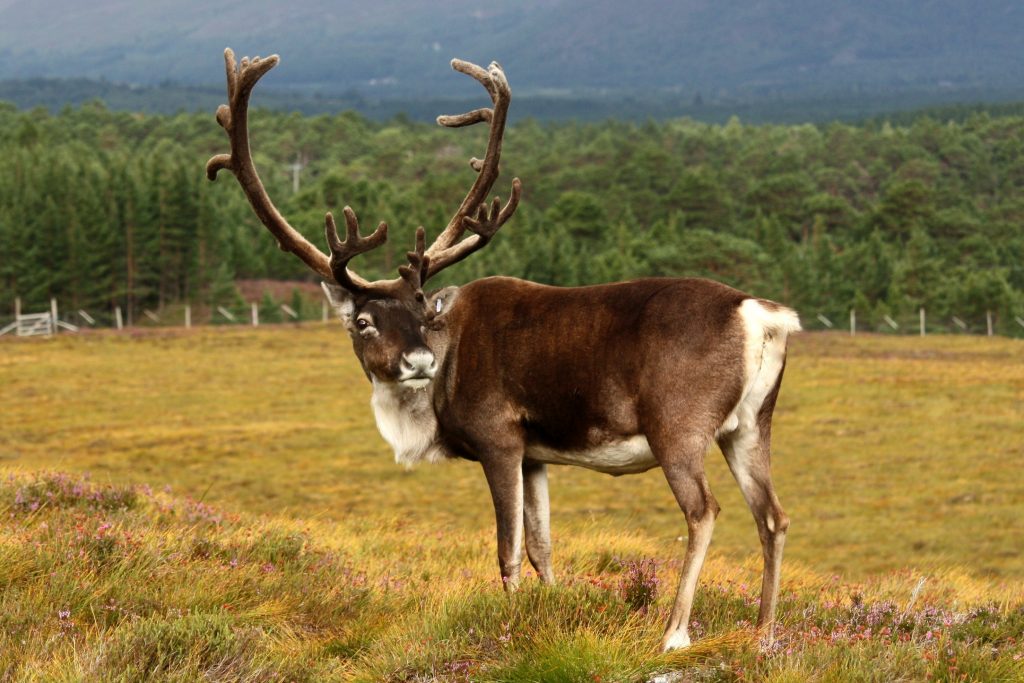
Merrick:
As a calf Merrick came back from free ranging on the Cairngorms with his mother, Nepal. The calves only have very small antlers at that age and in Merrick’s case he only had a little stump on top of his head. It wasn’t until a year later, when they grow their antlers between March and August that we realised Merrick’s quirk! He only grew one antler! We have seen this before but only in female reindeer, never in the male reindeer. In fact Dixie a 12 year old female only grows one antler and also Brimick, a female reindeer the same age as Merrick only grows one antler as well as reindeer from the past – Ferrari, Cherry and Walnut. This is the first time we have seen this in a male and now he is 3 years old he looks rather silly just growing one antler. The female reindeer don’t grow antlers quite as big as the males so who knows what size it will get to. Will it only grow the same size as a normal antler or will the growth of two antlers go into the one… We have no idea?!?! Even though he grows just the one we still see him tapping the top of head where the other antler should grow so maybe one day, if he taps enough, he might grow another antler… Watch this space!
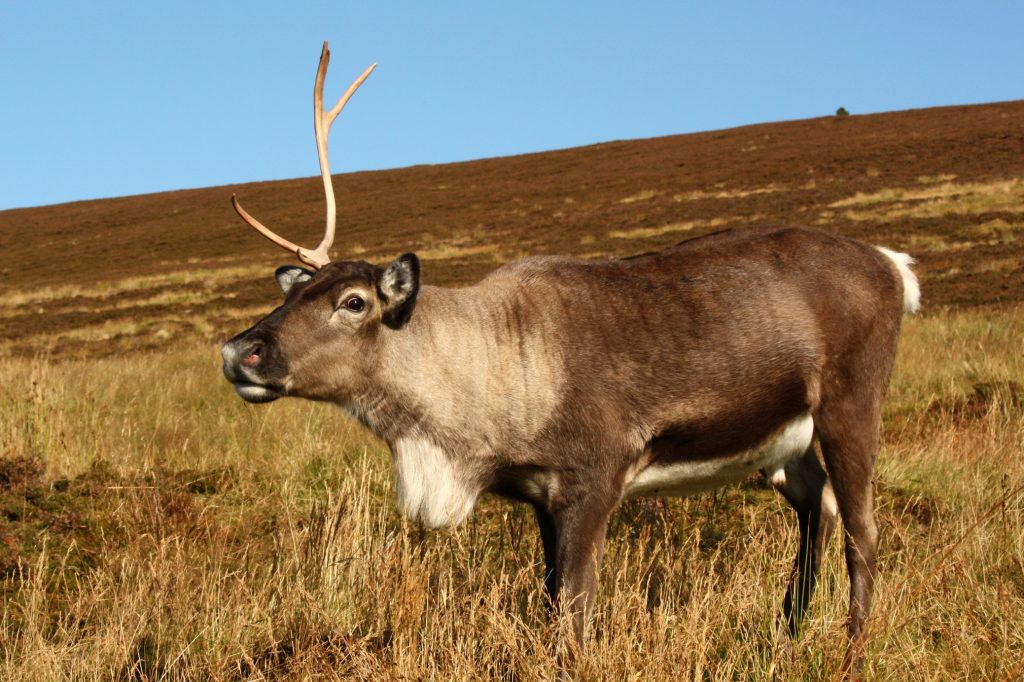
Starsky and Hutch:
No doubt you will all know about the twins by now and how rare it is within reindeer to have twins. In May 2018 we had our first pair of surviving twins, Starsky and Hutch. Their mother, Lulu, was an older female and seemed to take them on no bother at all. Like human twins, although they looked quite similar their characters were completely different from one another – this isn’t something I can necessarily describe in writing but when us herders spend everyday with them and we get to know their characters inside out we can tell that the two of them were very different. Sadly we didn’t get the many years of enjoying them together as we lost Hutch very recently, at 4 months old, but it was first for the Cairngorm Reindeer Herd and very rare in reindeer herds across the world. Our attention will now be focused on looking after Starsky.
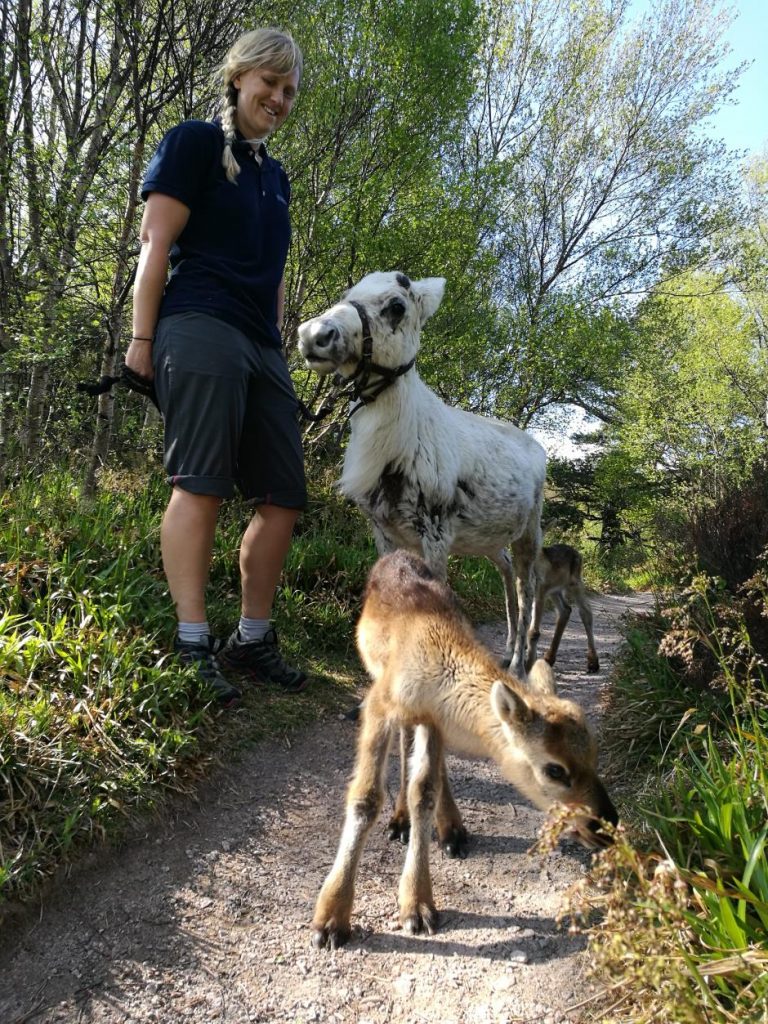
Fiona
I took photos with the purpose of writing this blog in September 2017, and then everything got too busy and I didn’t manage to actually write it. But here it is finally, so late that the subject matter has effectively come back into fashion once again! All the photos below are from last year (or earlier), rather than this year however.
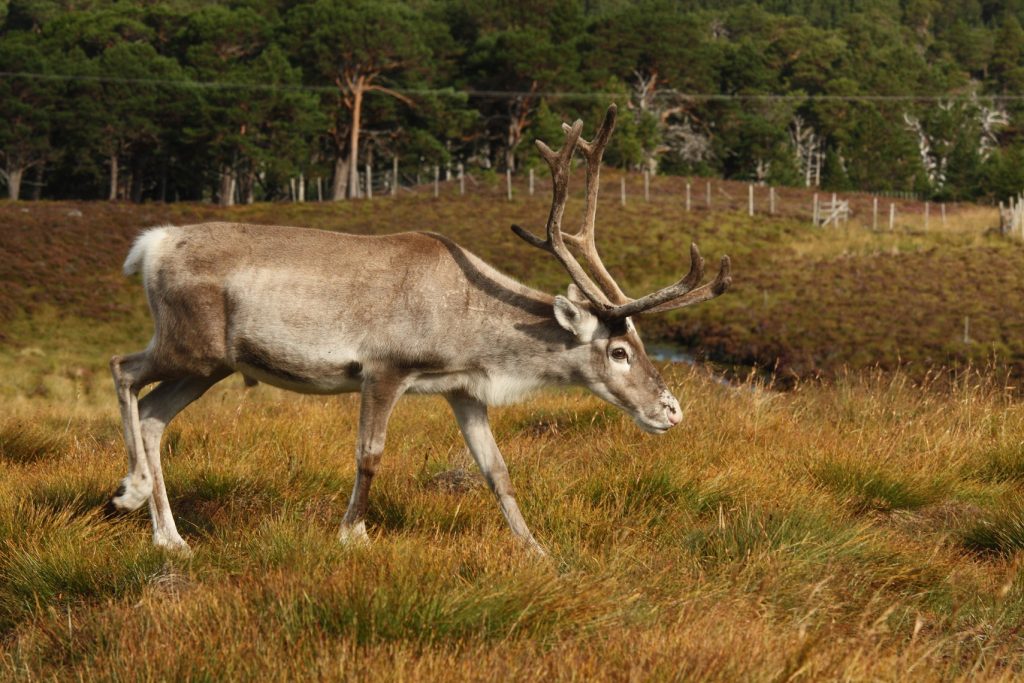
Reindeer antler is made of bone, and bone needs a blood supply for it to grow. Antlers start growing in the spring and at this point the soft, growing bone is covered with a layer of ‘velvet’ – a thin, hair-covered skin which is full of blood vessels and nerves. Late August and September are the months when reindeer finish growing their antlers each year, the bone hardens up, and then the ‘velvet’ skin strips away. Now, this can be a bit of a gory affair if you don’t know what to expect, so read on with caution if inclined to be a little squeamish. Although depending on what size of computer or phone screen you’re reading this on… it might be too late already. Sorry.
I could write all day about antlers, but to cut a long story short (for now at least), the antlers reach full grown at the end of the summer and then the bone hardens up, and finally the blood supply to them cuts off right at the base. This means that the velvet skin is effectively then just dead tissue, and that dead tissue needs to come away. You can’t be a big scary bull during the breeding season if you have cute fluffy antlers on your head…
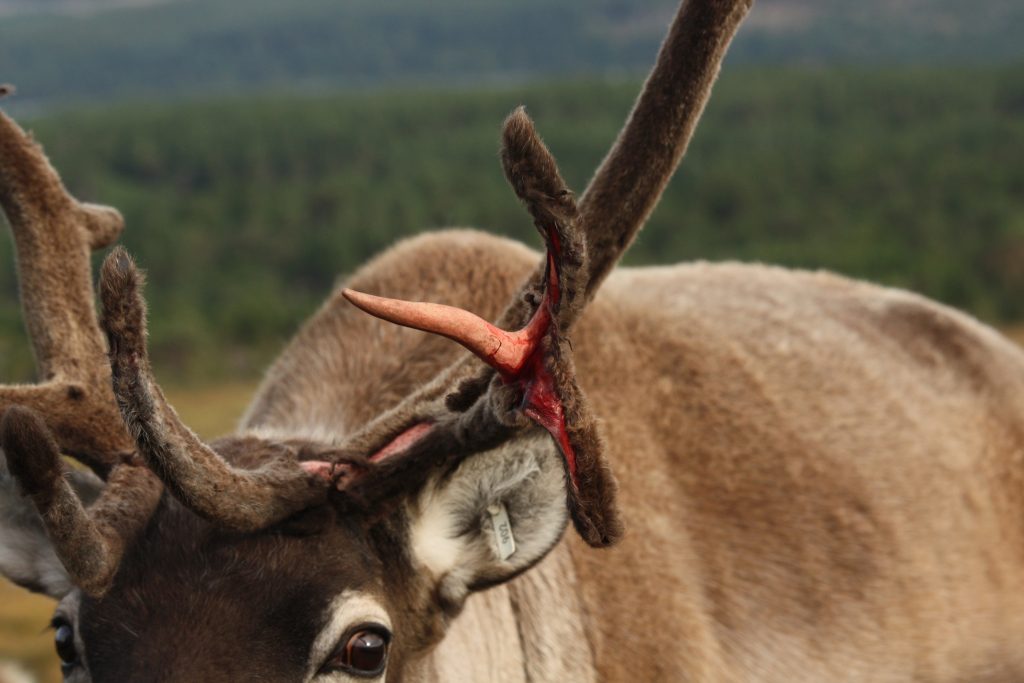
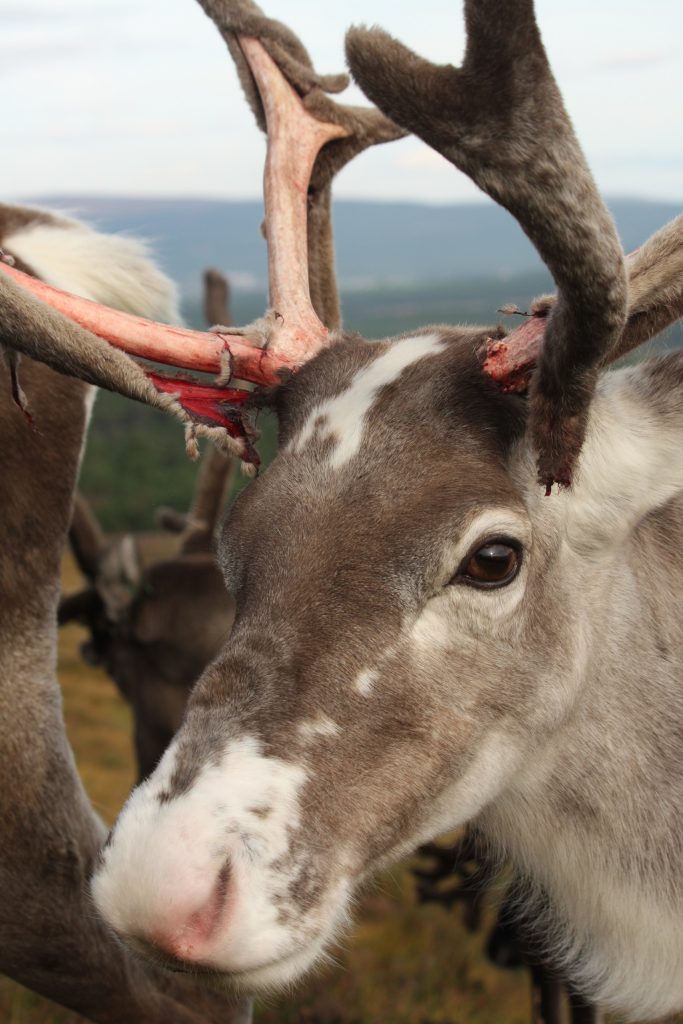
The first reindeer to ‘strip’ their velvet each year are the mature bulls, starting at the end of August. They are followed but the younger bulls in early September, and then the cows will strips their throughout the rest of September and into October. The castrated males, or ‘Christmas reindeer’ as we call them, are slightly different as they no longer have a hormonal trigger to strip the velvet away as their hormone balance has changed. They do still strip their velvet, but slowly and over the course of months as opposed to the space of a couple of days.
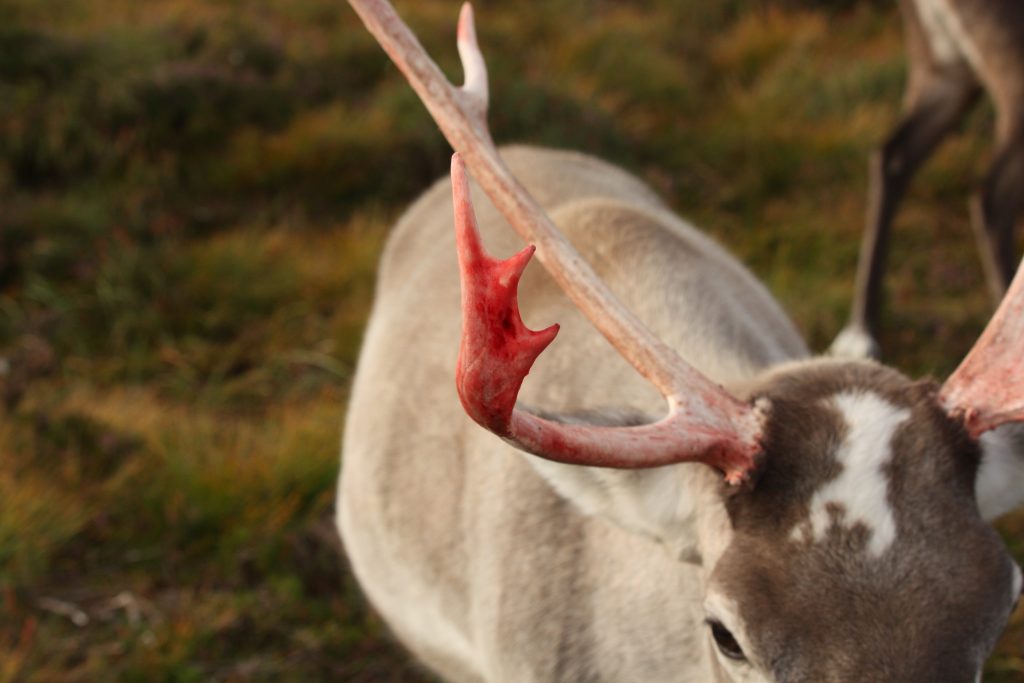
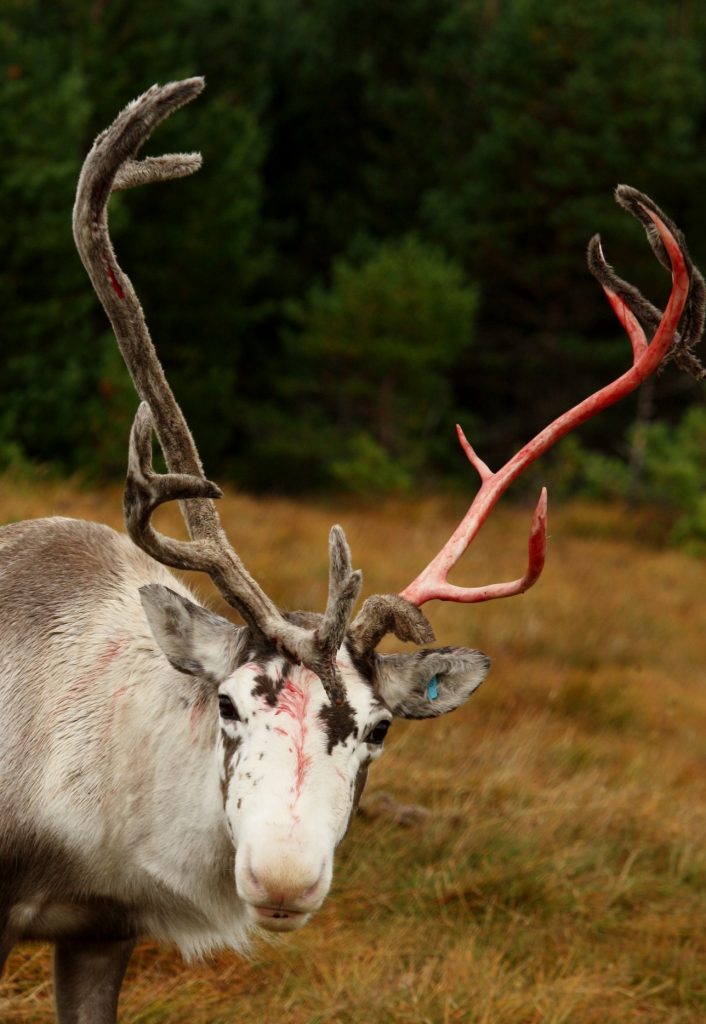
Although the blood supply to the velvet has cut off, there is still residual blood remaining in the blood vessels of the velvet, so stripping can be a gruesome affair at times. There is no feeling left in the antlers by this point however so it is completely painless, and this is a fact we have to drum into to all visitors before they come face to face with a reindeer whose skin appears to be falling off! It’s not a good look. But for those visitors who are feeling brave, I take great delight in showing them a section of freshly stripped velvet as the blood vessels are visible, making it easier to explain the process of the antler’s growth. I find kids are generally well impressed and want to poke at the bloody skin, whereas adults are often a little grossed-out and not keen to touch!
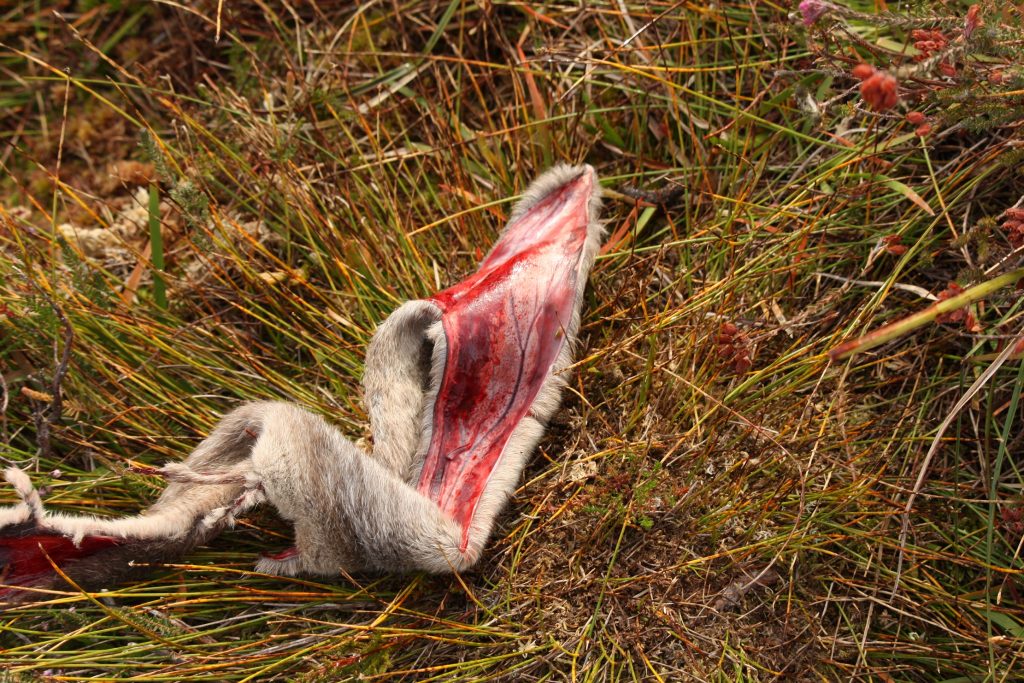
Once the antlers are clean of velvet, they tend to be a bit red-tinted from the blood until there’s been a rain shower, and then they are a more normal, ‘bone’ colour. And then it’s time for all hell to break loose, as the young bulls start squaring up to each other and the big bulls have to be separated from the herd for the safety of the visitors each day, until they can be split up and moved to closed off sections of the hill enclosure with a group of females apiece. The rut has arrived!
Hen
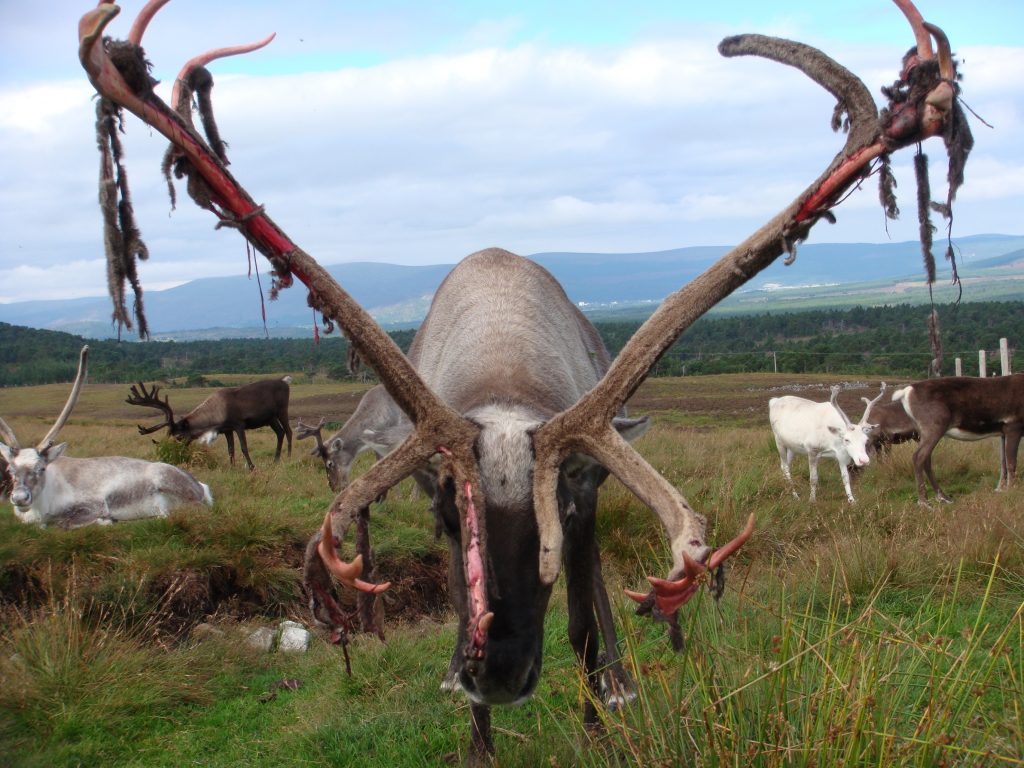
Reindeer bull Moskki stripping his velvet
At the start of August, Lotti and myself were sent out into the mountains to see if we could find the free-ranging females and their calves. Fiona had spied a big herd from the road and thought it would be a good idea to get them to follow us for as long as possible with a bag of food, in preparation for the rutting season where the females will need to be led back into the enclosure. With our lunches packed and a bag of feed each in our rucksacks, Lottie and myself set off for a day searching for reindeer.
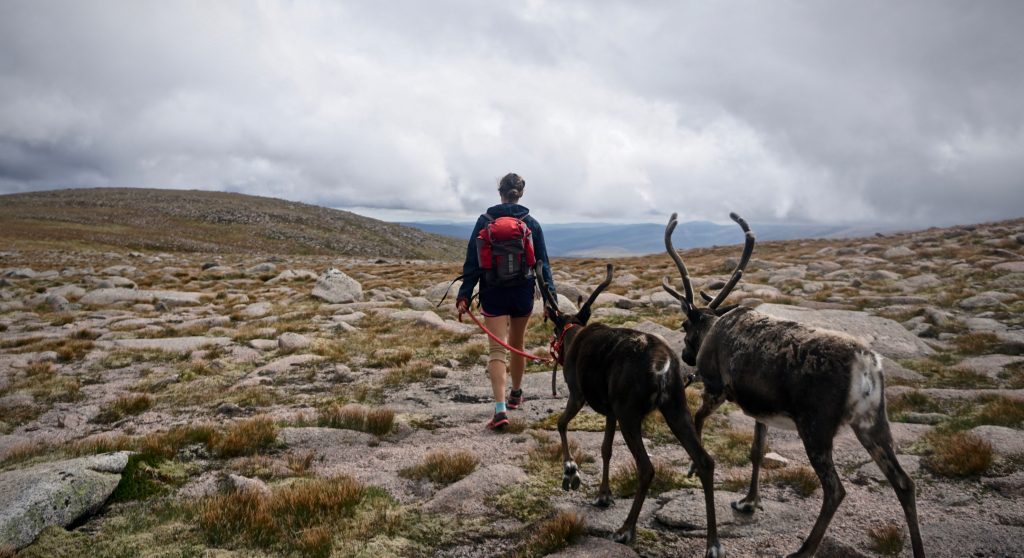
At the Ptarmigan restaurant, at the top of the funicular train line, we were rewarded with the sight of a large group of 20 females and two calves. Three females immediately ran over as soon as they caught sight of us removing a feed bag from Lottie’s rucksack. These turned out to be Hopscotch and her yearling Kipling. Hopscotch’s three-year-old son, Kips, is a regular on the handfeed line on hill trips and it was easy to see where he had inherited his greediness from! The third was a little reindeer called Pagan who proceed to half-heartedly shake her antlers on our legs in an effort to receive some food.
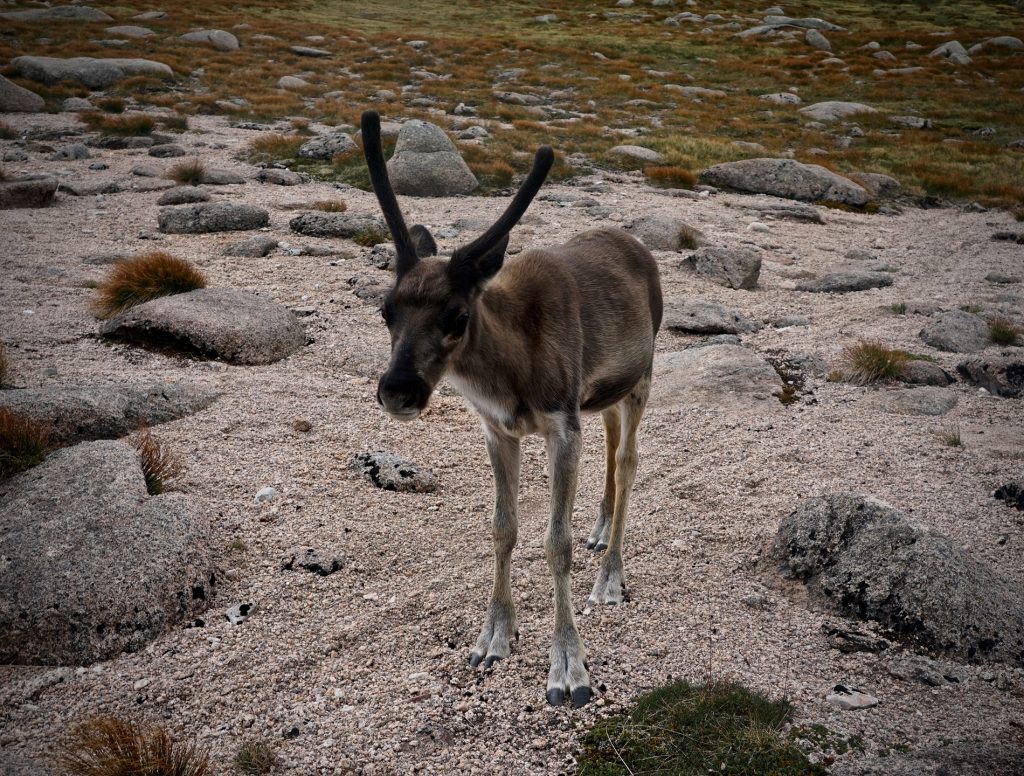
With Lotti leading and myself following at the back, we managed keep the females as a group and walking for a good half hour around the plateau. We gave up when the herd started to trot off in all directions and no amount of running behind in zigzags would keep them together. We had just made the decision to put the feed out, when Lotti looked behind and discovered another large group of twentyish females had joined us! After putting a long line of food, we counted 43 reindeer in total.
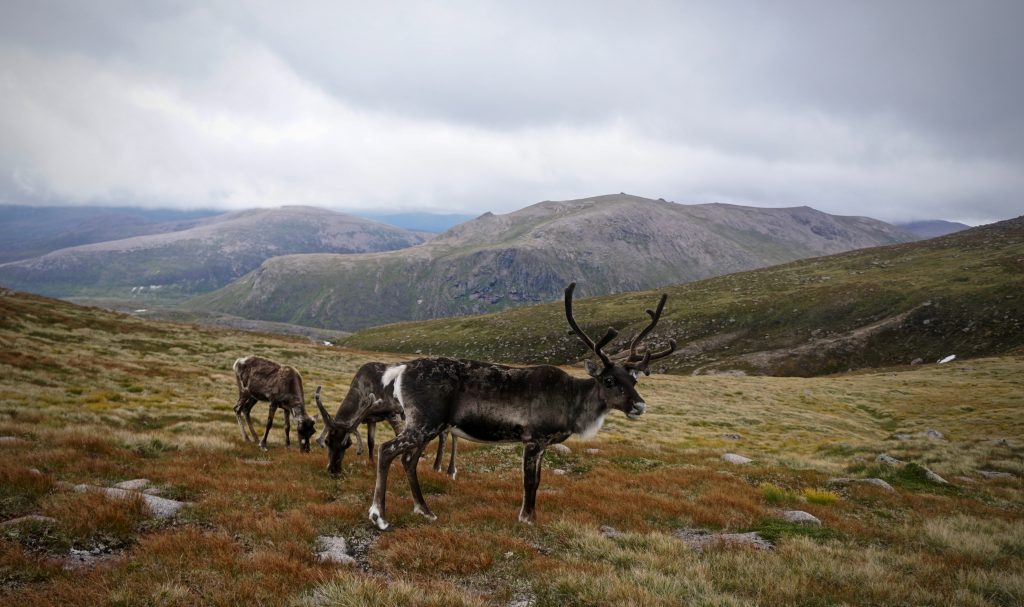
Once everyone was fed (including ourselves), the reindeer trotted off as one big herd, moving quickly across the mountain which was amazing to watch. Lottie and myself then headed to the summit of Cairn Gorm and around the Northern Corries in the hope of finding another group. Unfortunately, we spent the rest of the day searching for reindeer to no avail. We did however, have the most amazing day walking around the mountains, in shock the whole way that we were getting paid for this! I often have people telling me on hill trips that I have the best job in the world, and after this day out in the mountains, I would find it hard to disagree with them.
Julia
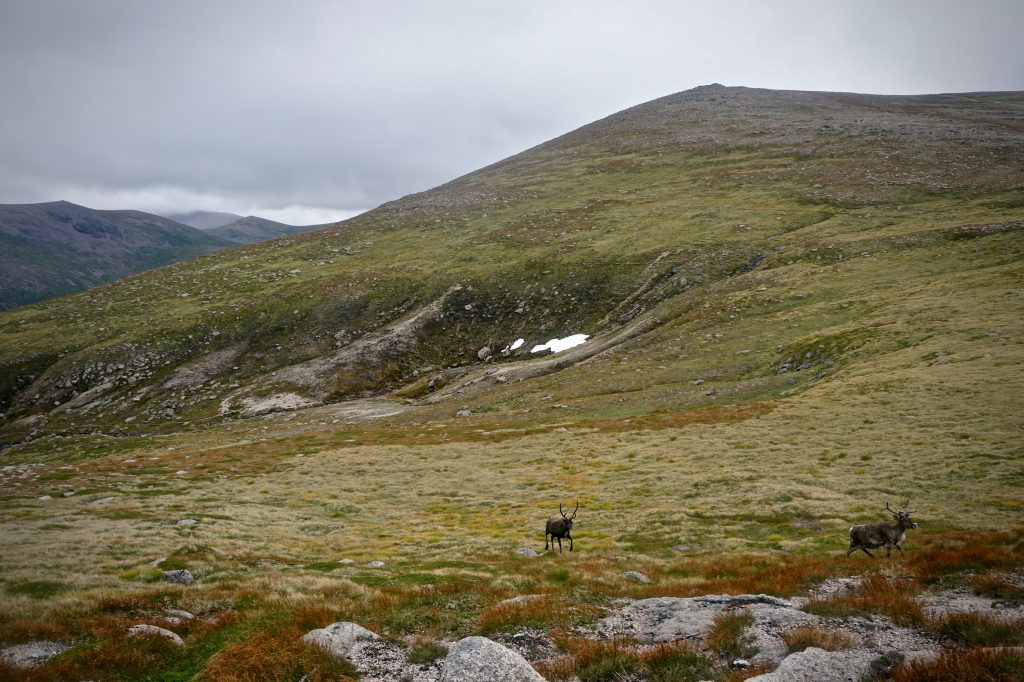
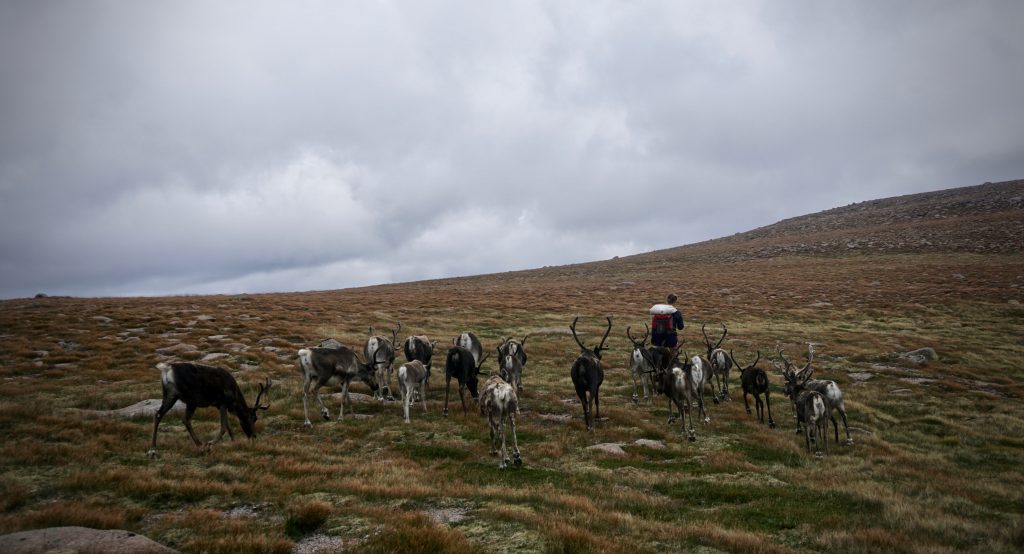
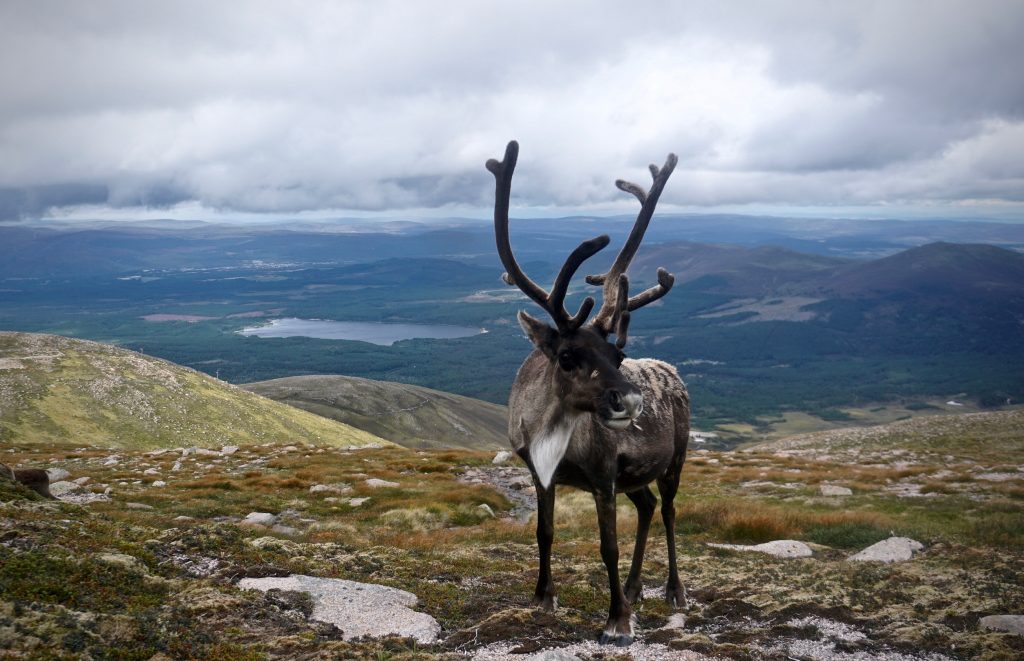
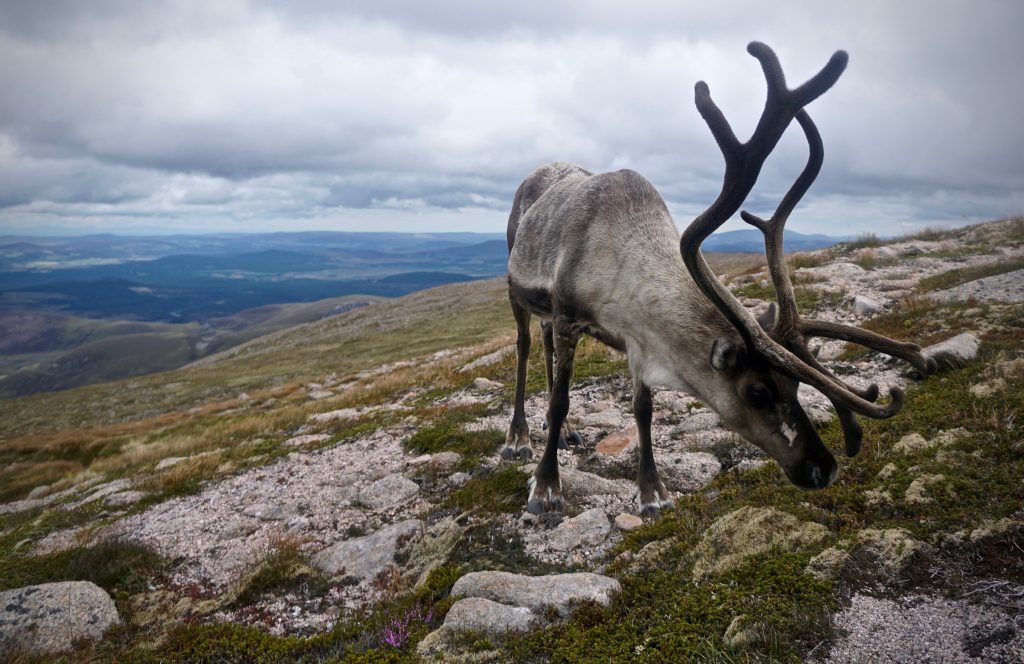
My first time meeting Fly. Her antlers were incredible with one side towering over the other. Apparently she lost one of her antlers a lot later than the other, causing the mismatching in their size.
